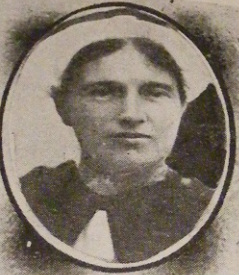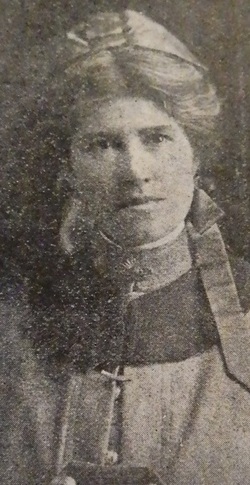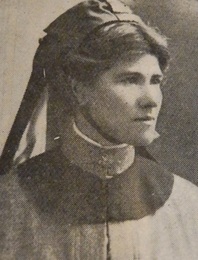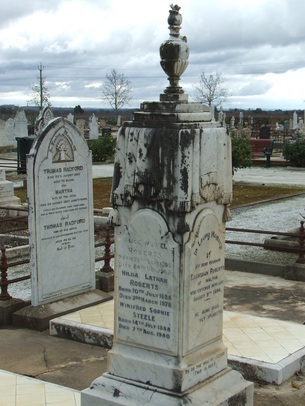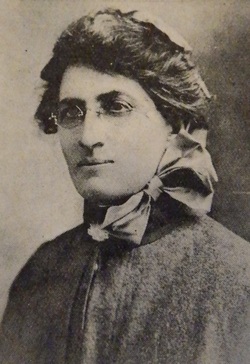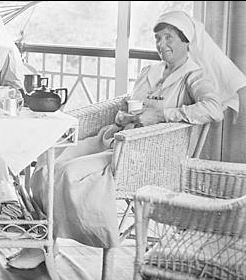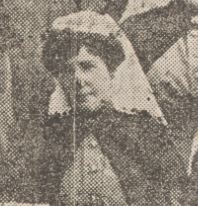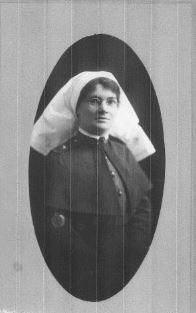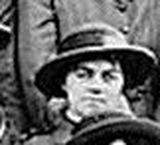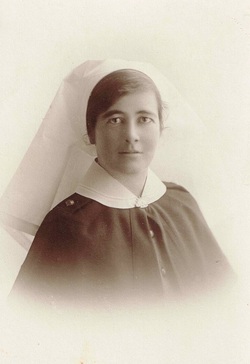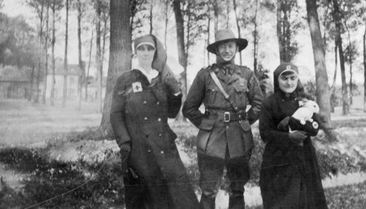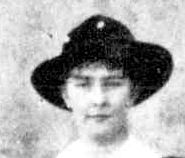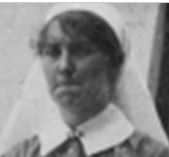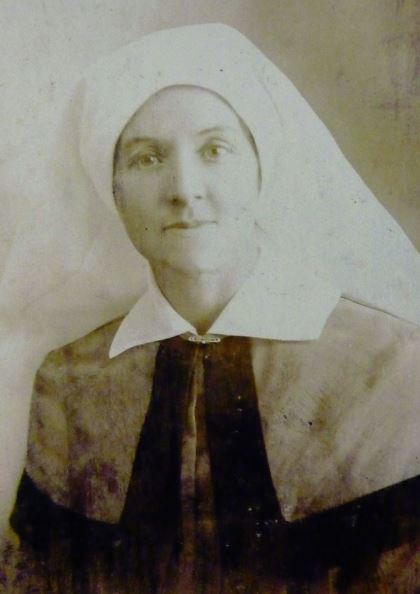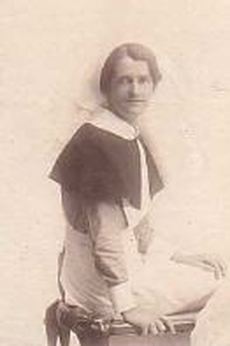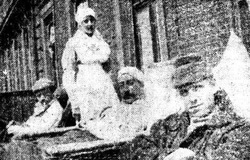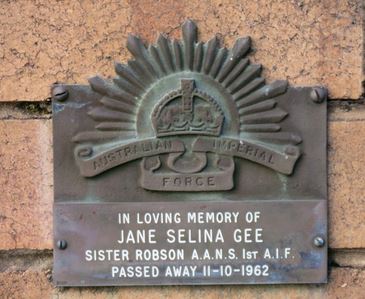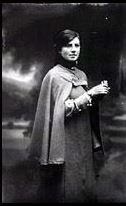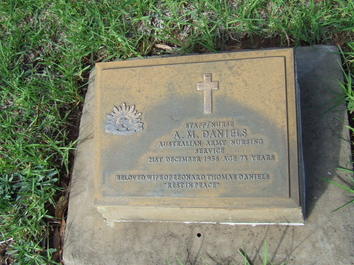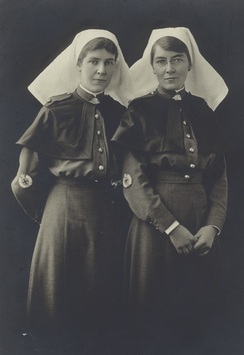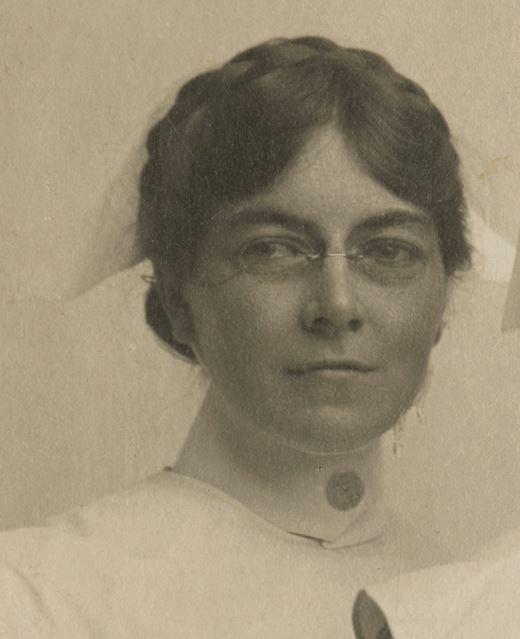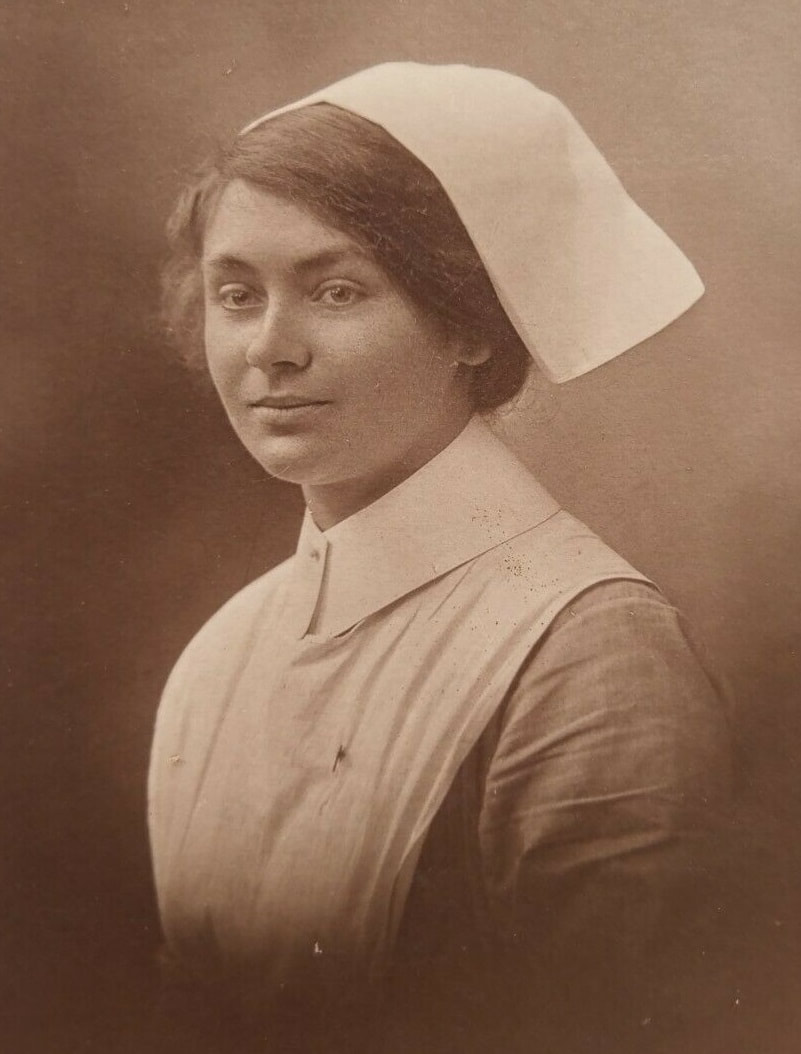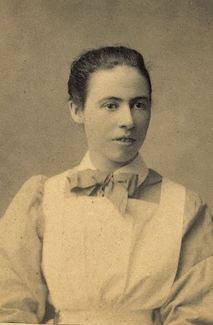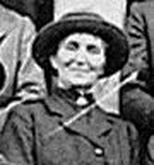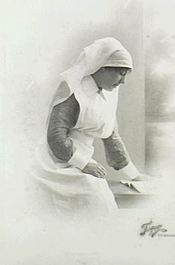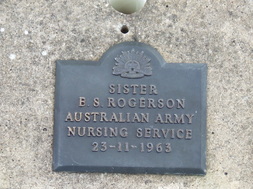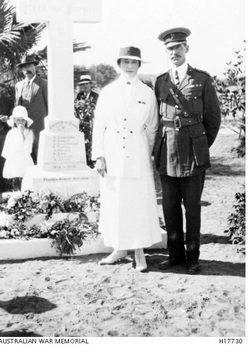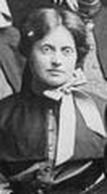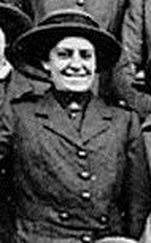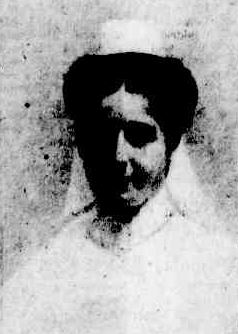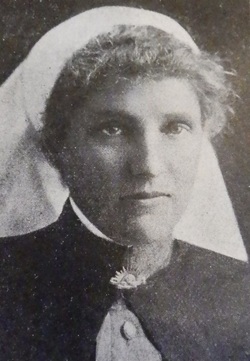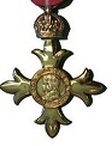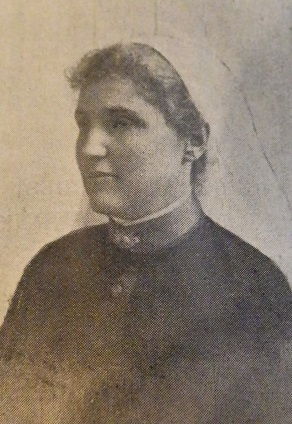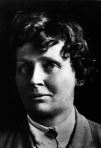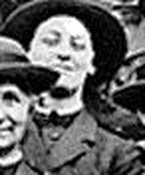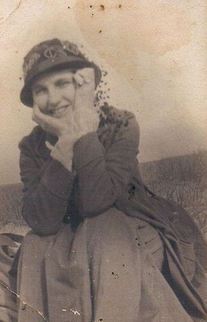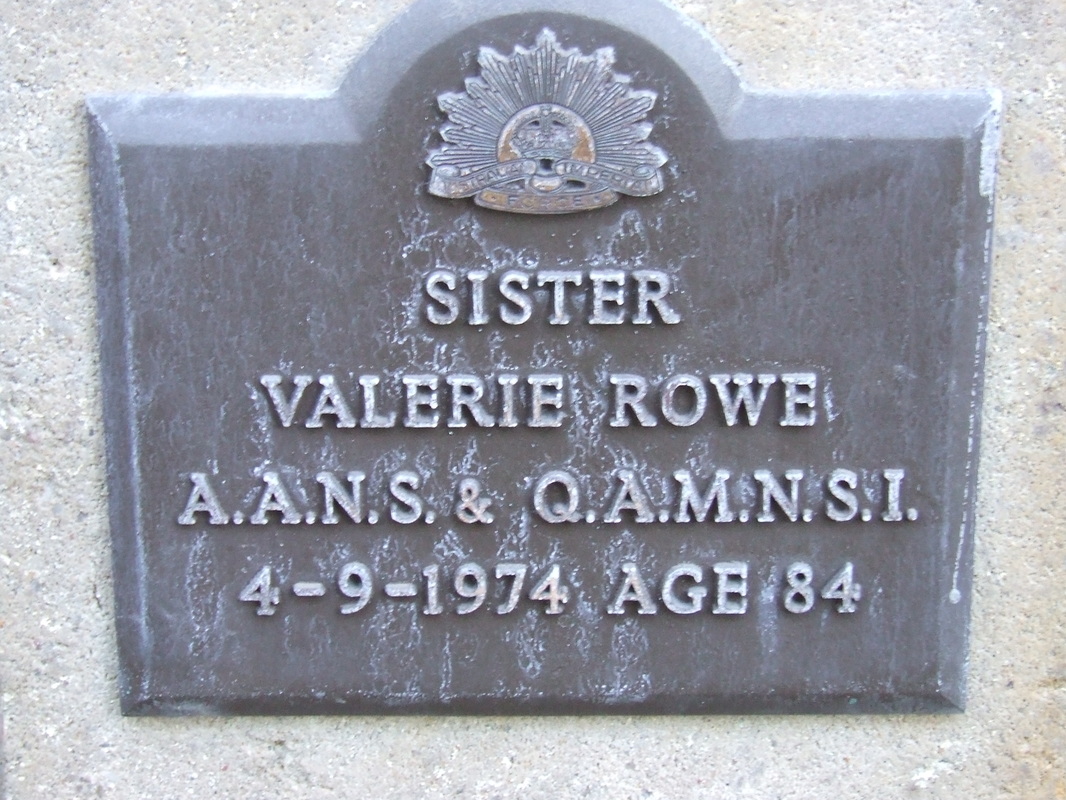ROACH, Dorothy
|
Staff Nurse
AANS Born 30 May 1886 at Aberdeen, SA Daughter of Henry ROACH and Minetta nee LANE Of Aberdeen, Burra, SA Occupation prior to enlistment Nurse Aged 30 years Enlisted 01 September 1917 at Keswick, SA Embarked 15 September 1917 Served in Egypt and England Returned to Australia 12 December 1919 per 'Nestor' Appointment terminated 29 December 1919 |
Staff-Nurse D. Roach is having a busy time, and apparently enjoying her wor kat the military hospital to which she is attached. In the course of a letter to a friend, she says that they had just concluded their Xmas festivities, when everything possible to had been done by the medical staff and nurses to brighten the lot of our wounded and sick soldiers. A convoy of wounded were brought in on Xmas-eve and she says these splendid fellows' appreciation was good to see.
Among the contributors in providing Xmas Cheer for the men in that hospital was the Sultan of Egypt, who had sent them a cheque for 20 pounds for that purpose. Many of the men referred to the contrast in their lot, to the lot of the men they had left behind in the trenches. All, however, seemed to have a very happy day, and for a while, to put cares and ailments aside and enjoy themselves in true Xmas fashion. Nurse Roach sends her good wishes and greetings to all Burra friends.
Burra Record Wednesday 20 February 1918 page 3
Among the contributors in providing Xmas Cheer for the men in that hospital was the Sultan of Egypt, who had sent them a cheque for 20 pounds for that purpose. Many of the men referred to the contrast in their lot, to the lot of the men they had left behind in the trenches. All, however, seemed to have a very happy day, and for a while, to put cares and ailments aside and enjoy themselves in true Xmas fashion. Nurse Roach sends her good wishes and greetings to all Burra friends.
Burra Record Wednesday 20 February 1918 page 3
ROBBINS, Ivy Louisa
Staff Nurse
AANS
Born 1890 in Newcastle, NSW
Daughter of Evelyn Edward ROBBINS and Marion/Mary Ann nee HENDRY
Age 26 years
Enlisted 22 May 1917
Embarked 12 June 1917 in Melbourne per “Mooltan”
Service in Salonika and England
Returned to Australia 01 July 1919 per “Karmala” On Duty
Appointment terminated 17 September 1919
Repatriation contact 22 January 1960
Married Woodford Harris PATCHELL in 1936
Died 29 February 1976 in NSW
Late of St. Ives, NSW
AANS
Born 1890 in Newcastle, NSW
Daughter of Evelyn Edward ROBBINS and Marion/Mary Ann nee HENDRY
Age 26 years
Enlisted 22 May 1917
Embarked 12 June 1917 in Melbourne per “Mooltan”
Service in Salonika and England
Returned to Australia 01 July 1919 per “Karmala” On Duty
Appointment terminated 17 September 1919
Repatriation contact 22 January 1960
Married Woodford Harris PATCHELL in 1936
Died 29 February 1976 in NSW
Late of St. Ives, NSW
NURSE ROBBINS.
Mr. E. E. Robbins, of Newcastle, yesterday received a cable message from Salonica from his daughter, Staff-nurse Ivy Robbins, announcing her safe 'arrival at the 60th General Hospital. Nurse Robbins was trained at the Newcastle Hospltal, and left for the front by the steamer Mooltan, and was landed in Egypt a day prior to the steamer being torpedoed.
Newcastle Morning Herald & Miners' Advocated Wednesday 22 August 1917 page 7
Mr. E. E. Robbins, of Newcastle, yesterday received a cable message from Salonica from his daughter, Staff-nurse Ivy Robbins, announcing her safe 'arrival at the 60th General Hospital. Nurse Robbins was trained at the Newcastle Hospltal, and left for the front by the steamer Mooltan, and was landed in Egypt a day prior to the steamer being torpedoed.
Newcastle Morning Herald & Miners' Advocated Wednesday 22 August 1917 page 7
ROBERTS, Annie Florence
|
Sister/Temporary Matron
AANS Born 1879 in Ballarat, Vic Daughter of John Cymro ROBERTS and Emma nee CORNISH Address 36 Loch Ave, Ballarat, Vic Age 35 years Training Ballarat Hospital Enlisted 17 July 1915 Embarked 22 December 1915 “Orsova” to UK for transport duty Duty on Hospital Ship “Kanowna” Re-embarked 26 December 1916 in Melbourne per “Mooltan” Service in India and Hospital Ship “Ellora” Promoted to Temp Matron 28 February 1918 Returned to Australia per “Eastern” 13 April 1919 Appointment Terminated 15 January 1920 Did not marry Died 18 July 1958 in Heidelberg, Vic. Resided East Melbourne, Vic. Cremated 22 July 1958 at Springvale Botanical Cemetery Tristiana Garden F3 Bed 7 Rose 11 Table Talk Thursday 26 August 1915 page 3 Punch Thursday 29 July 1915 page 21 |
ROBERTS, Elizabeth
Staff Nurse
AANS
Born 1886 in Armidale, NSW
Daughter of Mark ROBERTS and Sarah Ann nee PORTER
Age 30 years
Enlisted 11 May 1917
Embarked 12 June 1917 in Melbourne per “Mooltan”
Service in Egypt
Returned to Australia 27 July 1919 per “Hungaria” On Duty
Appointment terminated 10 September 1919
Married John SHORT in 1920
Died 25 July 1947
Aged 61 years
Buried Amidale Cemetery, NSW
AANS
Born 1886 in Armidale, NSW
Daughter of Mark ROBERTS and Sarah Ann nee PORTER
Age 30 years
Enlisted 11 May 1917
Embarked 12 June 1917 in Melbourne per “Mooltan”
Service in Egypt
Returned to Australia 27 July 1919 per “Hungaria” On Duty
Appointment terminated 10 September 1919
Married John SHORT in 1920
Died 25 July 1947
Aged 61 years
Buried Amidale Cemetery, NSW
Mrs. Elizabeth Short
Mrs. Elizabeth Short, wife of Mr. John Short, of Exmouth, died this morning in her sleep at her home at Exmouth. She was 61 years of age and had been treated for heart trouble for the past two years.
Deceased was born in Armidale. She was the daughter of the late Mr. and Mrs. Mark Roberts. She trained at Armidale and New England Hospital as a nurse when Mrs.R. N. Hickson, then Matron Bell, was matron of the hospital. She saw service at Egypt and Bombay as a sister in the first A.I.F.
After returning to Australia deceased was on the staff of Randwick Military Hospital for a number of years.
On her marriage 27 years ago deceased went to live, at Exmouth. She retained her interest in the welfare of servicemen and women, and was an active member of the Dumaresq branch of the Red Cross Society.
Deceased is survived by. her husband and two daughters. The daughters are Mrs. Joe Young (Dulwich Hill) and Miss Sybil Short, of Exmouth.
Mr. Arthur Roberts (Moore Park, Armidale) is a brother, and Mrs. H.S. Short (Moore Park, Armidale) is a sister.
The funeral will take place tomorrow afternoon, leaving St.Peter's Cathedral, Armidale, at 2.30 o'clock, for Armidale cemetery.
Piddington's have charge of arrangements.
The Armidale Express and New England General Advertiser Friday 25 July 1947 page 16
Mrs. Elizabeth Short, wife of Mr. John Short, of Exmouth, died this morning in her sleep at her home at Exmouth. She was 61 years of age and had been treated for heart trouble for the past two years.
Deceased was born in Armidale. She was the daughter of the late Mr. and Mrs. Mark Roberts. She trained at Armidale and New England Hospital as a nurse when Mrs.R. N. Hickson, then Matron Bell, was matron of the hospital. She saw service at Egypt and Bombay as a sister in the first A.I.F.
After returning to Australia deceased was on the staff of Randwick Military Hospital for a number of years.
On her marriage 27 years ago deceased went to live, at Exmouth. She retained her interest in the welfare of servicemen and women, and was an active member of the Dumaresq branch of the Red Cross Society.
Deceased is survived by. her husband and two daughters. The daughters are Mrs. Joe Young (Dulwich Hill) and Miss Sybil Short, of Exmouth.
Mr. Arthur Roberts (Moore Park, Armidale) is a brother, and Mrs. H.S. Short (Moore Park, Armidale) is a sister.
The funeral will take place tomorrow afternoon, leaving St.Peter's Cathedral, Armidale, at 2.30 o'clock, for Armidale cemetery.
Piddington's have charge of arrangements.
The Armidale Express and New England General Advertiser Friday 25 July 1947 page 16
ROBERTS, Edith Hannah
Sister
AANS
Born 24 April 1893 in Daylesford, Vic.
Daughter of Horace Henry ROBERTS and Sarah Ann nee WADDINGTON
Age 24 years
Training Castlemaine Hospital
Enlisted 05 July 1917
Embarked 31 August 1917 in Sydney per “Wiltshire”
Service Egypt and Salonika
Returned to Australia 02 June 1919 per “Beltana” On Duty
Appointment terminated 03 September 1919
Did not marry
Died 15 October 1977 in Balwyn, Vic.
Late of Balwyn, Vic.
Cremated 18 October 1977 at Springvale Botanical Cemetery
AANS
Born 24 April 1893 in Daylesford, Vic.
Daughter of Horace Henry ROBERTS and Sarah Ann nee WADDINGTON
Age 24 years
Training Castlemaine Hospital
Enlisted 05 July 1917
Embarked 31 August 1917 in Sydney per “Wiltshire”
Service Egypt and Salonika
Returned to Australia 02 June 1919 per “Beltana” On Duty
Appointment terminated 03 September 1919
Did not marry
Died 15 October 1977 in Balwyn, Vic.
Late of Balwyn, Vic.
Cremated 18 October 1977 at Springvale Botanical Cemetery
ROBERTS, Evelyn Mary
|
Sister
AANS Born 1890 in Busselton, WA Daughter of William Alexander ROBERTS and Mary nee LONGBOTTOM Age 27 years Training Perth Children’s Hospital Enlisted 11 December 1916 Embarked 18 December 1916 in Fremantle per “Kaiser-I-Hind” Service in Egypt Resigned appointment in UK 09 August 1919 due to marriage Married Frank Roland BUCKLEY Died 17 September 1966 in Fulham, London Photograph courtesy of Russell Smith |
ROBERTS, Hilda Latham
|
Staff Nurse
AANS Born 10 July 1886 at Walton near Greenock, SA Daughter of Earnshaw ROBERTS and Alice Jane nee LATHAM NOK Mother Mrs ROBERTS of 45 Fifth Ave, St Peters,SA Age 32 years Training at Adelaide University Date of Appointment 10 November 1915 Transferred to Tasmania 06 November 1919 No record of war or influenza service Did not marry Died 03 March 1978 in Angaston, SA Buried Angaston Cemetery Courtesy of Gravesecrets at your fingertips! |
ROBERTS, I L
Staff Nurse
AANS
Enlisted 02 May 1917
Embarked 12 June 1917
Appointment terminated 17 September 1919
AANS
Enlisted 02 May 1917
Embarked 12 June 1917
Appointment terminated 17 September 1919
ROBERTS, Mary Elizabeth Jane
|
Staff Nurse
AANS Born 1873 in Alexandra, Vic. Daughter of Thomas Frederick ROBERTS and Elizabeth nee COUCH Age 42 years Training Melbourne Hospital Enlisted 11 August 1915 Embarked 24 August 1915 per “Morea” Service in Egypt briefly Returned to Australia per “Themistocles” Appointment terminated 17 January 1916 Continued to nurse at No 5, No11 and No14 Australian General Hospitals Did not marry Died 21 February 1955 in St. Kilda, Vic. Late of St. Kilda, Vic. Cremated 23 February 1955 Springvale Botanical Cemetery and remains scattered |
ROBERTS, Mildred Ellen
Sister
Queen Aelxandra Imperial Military Nursing Service Reserve
Daughter of Robert and Mary Ann ROBERTS
Of 43 Edward Street, Perth, WA
Embarked from Adelaide for England 1915
Arrived UK 07 March 1915
Came from Australian on a trip to the UK but joined the Service after a few months instead of returning to Australia
Enlisted QAIMNSR 03 June 1915
Posted to Beaufort War Hospital, Bristol 02 June 1915
Suffered Influenza 21 October 1918
Resigned on completion of contract 10 June 1919
Re-posted for temporary duty
Posted to Royal Herbert Hospital Woolwich for Transport duty 03 August 1919
Embarked for Australia 09 January 1920 per 'Megantic' at Liverpool for Sydney, NSW
Arrived Sydney 27 February 1920
In January 1920 resided at 'Grafton' Ellesmore Street, Kensington Sydney, NSW
In 1936 working at Baby Health Centre, Cowra, NSW
Did not marry
Died 02 February 1952 at Pymble, NSW
Queen Aelxandra Imperial Military Nursing Service Reserve
Daughter of Robert and Mary Ann ROBERTS
Of 43 Edward Street, Perth, WA
Embarked from Adelaide for England 1915
Arrived UK 07 March 1915
Came from Australian on a trip to the UK but joined the Service after a few months instead of returning to Australia
Enlisted QAIMNSR 03 June 1915
Posted to Beaufort War Hospital, Bristol 02 June 1915
Suffered Influenza 21 October 1918
Resigned on completion of contract 10 June 1919
Re-posted for temporary duty
Posted to Royal Herbert Hospital Woolwich for Transport duty 03 August 1919
Embarked for Australia 09 January 1920 per 'Megantic' at Liverpool for Sydney, NSW
Arrived Sydney 27 February 1920
In January 1920 resided at 'Grafton' Ellesmore Street, Kensington Sydney, NSW
In 1936 working at Baby Health Centre, Cowra, NSW
Did not marry
Died 02 February 1952 at Pymble, NSW
ROBERTSON, Agnes Kate
Staff Nurse
AANS
Born 02 September 1888 in Clerkenwell, England
Daughter of George ROBERTSON
Sister of Mary Helen CASE
Age 29 years
Enlisted 29 December 1917
Embarked 05 January 1918 in Adelaide per “Borda”
Service in England and France
Bronchial Pneumonia in February, Influenza in April 1919
Returned to Australia 01 August 1919 per “Argyleshire” On Duty
Appointment terminated 16 October 1919
Repatriation contact 08 July 1959
Married Norman Clyde ALLEN in 192
Died 14 October 1975 in Canberra, ACT
Late of Goodwin Homes, ACT
Aged 87 years
AANS
Born 02 September 1888 in Clerkenwell, England
Daughter of George ROBERTSON
Sister of Mary Helen CASE
Age 29 years
Enlisted 29 December 1917
Embarked 05 January 1918 in Adelaide per “Borda”
Service in England and France
Bronchial Pneumonia in February, Influenza in April 1919
Returned to Australia 01 August 1919 per “Argyleshire” On Duty
Appointment terminated 16 October 1919
Repatriation contact 08 July 1959
Married Norman Clyde ALLEN in 192
Died 14 October 1975 in Canberra, ACT
Late of Goodwin Homes, ACT
Aged 87 years
ROBERTSON, Dorothy Madeline
|
Staff Nurse/Sister
AANS Born 1889 in Waverley, Sydney, NSW Daughter of Allan ROBERTSON and Mary nee SMITH Address 9 Flood St., Bondi, NSW Age 25 years Enlisted 15 June 1915 Embarked 14 July 1915 per “Karoola” On Duty Service in, Lemnos, Egypy in the Field in France, and England Promoted to Sister 01 October 1918 Mentioned in despatches Returned to Australia 30 October per “Wahehe” On Duty Appointment Terminated 14 February 1920 Did not marry Died 05 July 1941 in Honolulu, Hawaii, USA |

Mentioned in Sir Douglas Haig’s Despatches 11 July 1919
8th Supplement London Gazette 31448
Commonwealth Gazette No 124 – 30 October 1919
8th Supplement London Gazette 31448
Commonwealth Gazette No 124 – 30 October 1919
ROBERTSON, Flora
|
Sister/ Head Sister
AANS Born Bathurst, NSW Sister of Mr. S B ROBERTSON Address c/o Dalgety &Co, Bent St. Sydney Age 38 years Enlisted 21 November 1914 Embarked 28 November 1914 at Sydney per “Kyarra” Service in Lemnos, Egypt, in the field in France and England Contracted Mumps May 1916 Returned to Australia 14 February 1918 per “Persic” On Duty Appointment Terminated 28 February 1918 Re-enlisted 04 April 1919 Re-embarked 05 April 1919 per “Melusia” Service as Matron at Namanula Hospital, Rabaul, New Guinea Contracted Malaria November 1920 Returned to Australia 23 November 1920 per “Maraina” Appointment Terminated 16 April 1921 Photograph Courtesy of Faye Threlfall WW1 Australian and New Zealand Nurses |
ROBERTSON, Gertrude Muriel Norton
Staff Nurse
AANS
Born St. Kilda, Vic.
Daughter of Robert ROBERTSON and Joanna Kate nee NORTON
Sister of Mary ROBERTSON
Read more here
AANS
Born St. Kilda, Vic.
Daughter of Robert ROBERTSON and Joanna Kate nee NORTON
Sister of Mary ROBERTSON
Read more here
ROBERTSON, Jeanie Gray
|
Staff Nurse
AANS Born 27 May 1891 in Geelong, Vic. Daughter of Rev. Colin ROBERTSON and Margaret Gray nee DIXON Age 26 years Trained at Wangaratta Hosptial Enlisted 06 July 1917 Embarked 31 August 1917 in Sydney per “Wiltshire” Service in Egypt Returned to Australia 30 October 1919 per “Wahehe” On Duty Appointment terminated 20 February 1920 Did not marry Died 14 February 1966 in NSW http://www.andrewwarland.com.au/robertson_australia/WilliamGDRobertsonWW1.html |
ROBERTSON, Lilian Katherine Dawson
|
Staff Nurse/Sister
AANS Born New Hebrides Daughter of Christina McNeil ROBERTSON Enlisted 11 May 1917 Embarked 12 June 1917 in Melbourne per “Mooltan” Service Egypt and England Promoted to Sister 12 July 1919 Returned to Australia 28 October 1919 per “Orontes” On Duty Appointment terminated 16 January 1920 Repatriation contact 28 November 1961 Did not marry Died 14 February 1966 Late of Lady Gowrie Red Cross Home, Gordon, NSW Formerly of Drummoyne |
ROBERTSON, Margaret Adie Wilberforce
Staff Nurse
AANS
Born Brynbo, Wales
Daughter of Daniel Alexander and Janet ROBERTSON
Age 37 years
Enlisted 27 August 1917
Embarked 10 September 1917 in Melbourne per “Runic”
Service in Egypt
Returned to Australia 24 July 1919 per “Dongola”
Appointment terminated 28 September 1919
Married James McINTOSH in 1927 in Lismore, NSW
Died 24 November 1980 in NSW
Aged 101 years
AANS
Born Brynbo, Wales
Daughter of Daniel Alexander and Janet ROBERTSON
Age 37 years
Enlisted 27 August 1917
Embarked 10 September 1917 in Melbourne per “Runic”
Service in Egypt
Returned to Australia 24 July 1919 per “Dongola”
Appointment terminated 28 September 1919
Married James McINTOSH in 1927 in Lismore, NSW
Died 24 November 1980 in NSW
Aged 101 years
ROBERTSON, Marjorie Bruce
Sister
AANS
Born 1893 in Katoomba, NSW
Daughter of George ROBERTSON and Elizabeth nee BRUCE
Next of kin Mary D ROBERTSON
Age 22 years
Enlisted 19 October 1915
Embarked 11 November 1915
Service in Egypt, England and France
Promoted to Sister 01 October 1918
Sick with Mumps March 1916
Returned to Australia 07 June 1918 per “Sussex” On Duty
Application to resign appointment 31 March 1919 denied due to Influenza outbreak
Appointment terminated 14 April 1919
Repatriation contact 07 January 1960
Married to John G BOYD in 1923 in NSW
Died 10 September 1980 at Narrabeen, NSW
Aged 87 years
Late of Vaucluse, NSW
AANS
Born 1893 in Katoomba, NSW
Daughter of George ROBERTSON and Elizabeth nee BRUCE
Next of kin Mary D ROBERTSON
Age 22 years
Enlisted 19 October 1915
Embarked 11 November 1915
Service in Egypt, England and France
Promoted to Sister 01 October 1918
Sick with Mumps March 1916
Returned to Australia 07 June 1918 per “Sussex” On Duty
Application to resign appointment 31 March 1919 denied due to Influenza outbreak
Appointment terminated 14 April 1919
Repatriation contact 07 January 1960
Married to John G BOYD in 1923 in NSW
Died 10 September 1980 at Narrabeen, NSW
Aged 87 years
Late of Vaucluse, NSW
ROBERTSON, Minnie Mabel Alexandra
|
Staff Nurse
Queen Alexandra Imperial Military Nursing Service Reserve Born 22 February 1872 at Colebrook Park, Colebrook, Tas. Daughter of Alexander ROBERTSON (sheep owner) and Charlotte Lavinia nee IBBOT Resided 'Colebrook Park', Colebrook, Tas. Educated with private tuition Trained at General Hospital Hobart May 1885 to March 1900 Resigned 01 April 1900 Arrived in UK 09 January 1915 Served in the Boer War From Australian Voluntary Hospital 01 July 1916 Appointed to QAIMNSR 07 July 1916 Sent to France 32 Stationary Hospital 01 July 1916 12 Ambulance Train 27 January 198 83 General Hospital 27 April 1918 12 Ambulance Train 01 May 1918 14 Stationary Hospital 17 July 1918 Admitted to 14 General Hospital 07 March 1919 with Urethral Caruncle - date of original disability 1912 in South America To UK sick 07 March 1919 Not returning to France Service terminated 15 November 1919 Total service 4 years and 4 months Aged 45 years Embarked for Australia 15 November 1919 per 'Ormonde' Did not marry Died 21 July 1956 in Hobart, Tas. Cremated Cornelian Bay Cemetery 24 July 1956, SCOT, K, No 2. |
NURSES FOR THE FRONT
HOBART, Monday.— By the steamer Aberdeen, which left here yesterday morning for the Cape, filters Mansfield and White and Nurse Robinson departed with the object of getting attached to the Red Cross Staff of the British Army. They carry with them letters of introduction to Sir Thomas Fitzgerald and the British medical officers from many of the leading doctors of Hobart, also one from the Governor (Lord Gormanston) to Sir Alfred Milner, Commissioner of South Africa. All the young ladies ate proceeding to the Seat of war at their own expense.
Daily Telegraph Tuesday 03 April 1900 page 2
HOBART, Monday.— By the steamer Aberdeen, which left here yesterday morning for the Cape, filters Mansfield and White and Nurse Robinson departed with the object of getting attached to the Red Cross Staff of the British Army. They carry with them letters of introduction to Sir Thomas Fitzgerald and the British medical officers from many of the leading doctors of Hobart, also one from the Governor (Lord Gormanston) to Sir Alfred Milner, Commissioner of South Africa. All the young ladies ate proceeding to the Seat of war at their own expense.
Daily Telegraph Tuesday 03 April 1900 page 2
HONOURED GUEST
In a place of honour at the Diggers' reunion in Hobart on Saturday night will be Miss Minnie M. Robertson, who served as a nurse in the Boer War. Miss Robertson, who is aged about 76, completed training with the General Hospital, Hobart, in 1899, and in that year sailed for South Africa. She stayed on there after the war and afterwards lived and worked in South America and England. In the First World War, Miss Robertson served, for more than four years. She now lives in Hobart, staying at the Nurses' Club in Macquarie St.
Mercury Tuesday 16 February 1954 page 4
In a place of honour at the Diggers' reunion in Hobart on Saturday night will be Miss Minnie M. Robertson, who served as a nurse in the Boer War. Miss Robertson, who is aged about 76, completed training with the General Hospital, Hobart, in 1899, and in that year sailed for South Africa. She stayed on there after the war and afterwards lived and worked in South America and England. In the First World War, Miss Robertson served, for more than four years. She now lives in Hobart, staying at the Nurses' Club in Macquarie St.
Mercury Tuesday 16 February 1954 page 4
ROBIN, Stella Agnes
|
Sister
AANS Born Victoria Daughter of Major Peter and Margaret ROBIN Age 28 years Training Melbourne Hospital Enlisted 10 May 1915 Embarked 18 May 1915 Service Lemnos, Egypt, England, France and on the field Promoted to Sister 05 July 1917 Returned to Australia 23 June 1919 per “Orita” On Duty Appointment terminated 26 October 1919 Died 30 March 1940 at 3 Field Street, McKinnon Late of McKinnon, Vic. Buried New Cheltenham Cemetery, Holloway Road. Courtesy of Bronwyn Roberts |
ROBINSON, Alice Elaine
|
Sister
French Red Cross Blue Birds Australian Red Cross (left) Born 1882 in Braidwood, NSW Daughter of Cecil Charles ROBINSON an dAlice Constance nee WAUGH Embarked for France 04 July 1916 from NSW per 'Kanowna' Returned to Australia 28 February 1919 per 'Anchises' Did not marry Died 16 August 1957 in NSW Late of Burrowa, NSW www.awm.gov.au P02298.004 |
ROBINSON, Catherine
|
Nurse
Queen Alexandra's Imperial Military Nursing Service Reserve Born 24 March 1878 at Pompapiel, Vic. Daughter of William ROBINSON and Catherine nee ROSS NOK listed as Hugh ROSS (Uncle) Of 'Riverside' Upper Tambo, Gippsland, Vic. Educated Pompapiel State School and Ladies College, Bendigo, Vic. Trained at Durban Goverment Hospital, South Africa - three years January 1901 - 1904 Lady Minto's Nursing Association India Private work and sometimes relieving in Hospital September 1905 - 1909 Civil Hospital Manika October 1909 - April 1910 - Charge Nurse Shanghai-Nanking Railway Hospital 1910 - 1912 Indian General Hospital, Brighton at 12 February 1915 Served as Staff Nurse QAIMNSR 03 February 1915 - 18 February 1916 Employed at Malta as a Staff Nurse May 1916 'I beg to inform you that she is reported as being an average Nurse, perfectly steady and reliable as regards conduct, obedient and pleasant. Miss Robinson resigned of her own accord her appointment in the QAIMNS Reserve. It is not possible therefore to re-engage her, as we have many Nurses waiting to be called up.' Applied to QAIMNSR 13 May 1917 whilst at Government Hospital, Suez, Egypt 'I have the honour to apply for membership of Queen Alexandria's Military Nursing Service Reserve. I have been engaged in Private work in Egypt, and am now doing temporary work for a few weeks at the Government Hospital, Suez.' |
Catherine was the fourth daughter of William and Catherine ROBINSON nee ROSS, who were farmers in the Pompapiel district, approximately fifty kilometres north of Bendigo, central Victoria. Her father was a native of Leek Frith, Staffordshire and he migrated to Victoria, Australia with his older sister Mrs Ruth PIMLOTT (1835-1912) in 1869. Catherine's mother was one of the very first European children to be born in the Williamstown district of west Melbourne in 1843.
Catherine was born at 5.00 am on the 24th of March 1878 at Pompapiel, Victoria. She was always known as Kate and she is believed to have left Australia with her brother William to serve in the Boer War in early 1902. Kate is assumed to have received her nursing training in Bendigo and following her training, she became as a British sponsored Queen Alexandria nurse. As a result, her name does not appear on any of the Australian Armed Forces nominal rolls.
After the Boer War, Kate moved to Europe. Whilst in Europe Kate’s experiences included a front-row-seat at the Crowning of King George V in 1911, nursing in the Indian and Chinese Plagues, the Balkan’s War of 1912-1913 and her crossing of the Khyber Pass. She briefly returned to Australia after the Balkan's War before sailing to Vancouver, Canada via Hong Kong and Yokohama, Japan on board the Monteagle. In December 1913 she moved to Vermont, USA before returning to England at the start of WW1.
During WW1, Kate was matron in charge of several hospitals. These included the Cairo Military Hospital, Egypt and a hospital ship, which was anchored off the Dardanelles during WW1. She was awarded the French Legion of Honour, assumedly for her nursing assistance to French Soldiers. Whilst overseas, Kate wrote lengthy letters to the local Inglewood (Victoria) Newspaper, describing the war and the latest nursing practices. There is no doubt she had a way with the pen.
Between the two world wars, Kate continued to travel the globe. In 1922 she was a nurse with the excavation party that opened the Tutankhamen tomb in Egypt. In 1926 she made the first of three known trips to Buenos Aries, Argentina. In 1931 she briefly returned to Australia to visit her relatives, before leaving for New York a few months later, this time with her cousin’s twenty-one year old daughter, Annette WAINWRIGHT (1910-2004). In 1932 Kate worked in a convent in San Antonia, Texas and the following year she returned to New York. During her travels she is said to have been the first white women to travel down the Amazon River and she wrote a total of seven books on travel and her unique experiences.
Kate’s last book, The Green Paradise: The story of a woman’s journey in the Amazon and the Argentine was written about the Amazon River and published by an Arthur BARRON of London on 1 January 1936. The Green Paradise lists the author as Catherine Louisa ROBINSON. This is the only known mention of the name Louisa as Kate’s middle name, suggesting the name was an adopted pen name. The book is listed on the web site www.alibris.com It appears that nearly all of her relatives received a copy. It was said to have been written whilst she was living in a small New York apartment. After the book was published, she again sailed to Australia, staying just a few months before she returned to England in the June, residing at Bloomsbury, London.
Her last known trip to central America was later that same year and she returned to Bloomsbury the following May. At the commencement of WW2 Kate re-joined the army, again as matron in charge of several military hospitals. Late in the war she was reluctantly given her retirements orders, due to her age. By then she was aged in her mid-sixties. In 1946 Kate returned to Australia, again visiting as many of her relatives as possible. She started with her sister Mrs. Sarah CLARK (1874-1969) in West Australia, before working her way across to the east coast and then north up to Queensland.
Catherine was born at 5.00 am on the 24th of March 1878 at Pompapiel, Victoria. She was always known as Kate and she is believed to have left Australia with her brother William to serve in the Boer War in early 1902. Kate is assumed to have received her nursing training in Bendigo and following her training, she became as a British sponsored Queen Alexandria nurse. As a result, her name does not appear on any of the Australian Armed Forces nominal rolls.
After the Boer War, Kate moved to Europe. Whilst in Europe Kate’s experiences included a front-row-seat at the Crowning of King George V in 1911, nursing in the Indian and Chinese Plagues, the Balkan’s War of 1912-1913 and her crossing of the Khyber Pass. She briefly returned to Australia after the Balkan's War before sailing to Vancouver, Canada via Hong Kong and Yokohama, Japan on board the Monteagle. In December 1913 she moved to Vermont, USA before returning to England at the start of WW1.
During WW1, Kate was matron in charge of several hospitals. These included the Cairo Military Hospital, Egypt and a hospital ship, which was anchored off the Dardanelles during WW1. She was awarded the French Legion of Honour, assumedly for her nursing assistance to French Soldiers. Whilst overseas, Kate wrote lengthy letters to the local Inglewood (Victoria) Newspaper, describing the war and the latest nursing practices. There is no doubt she had a way with the pen.
Between the two world wars, Kate continued to travel the globe. In 1922 she was a nurse with the excavation party that opened the Tutankhamen tomb in Egypt. In 1926 she made the first of three known trips to Buenos Aries, Argentina. In 1931 she briefly returned to Australia to visit her relatives, before leaving for New York a few months later, this time with her cousin’s twenty-one year old daughter, Annette WAINWRIGHT (1910-2004). In 1932 Kate worked in a convent in San Antonia, Texas and the following year she returned to New York. During her travels she is said to have been the first white women to travel down the Amazon River and she wrote a total of seven books on travel and her unique experiences.
Kate’s last book, The Green Paradise: The story of a woman’s journey in the Amazon and the Argentine was written about the Amazon River and published by an Arthur BARRON of London on 1 January 1936. The Green Paradise lists the author as Catherine Louisa ROBINSON. This is the only known mention of the name Louisa as Kate’s middle name, suggesting the name was an adopted pen name. The book is listed on the web site www.alibris.com It appears that nearly all of her relatives received a copy. It was said to have been written whilst she was living in a small New York apartment. After the book was published, she again sailed to Australia, staying just a few months before she returned to England in the June, residing at Bloomsbury, London.
Her last known trip to central America was later that same year and she returned to Bloomsbury the following May. At the commencement of WW2 Kate re-joined the army, again as matron in charge of several military hospitals. Late in the war she was reluctantly given her retirements orders, due to her age. By then she was aged in her mid-sixties. In 1946 Kate returned to Australia, again visiting as many of her relatives as possible. She started with her sister Mrs. Sarah CLARK (1874-1969) in West Australia, before working her way across to the east coast and then north up to Queensland.
|
Whilst visiting her sister Mrs. Mary PRYOR (1876-1960) and her cousin Mrs. Gwen TERRILL nee ROSS (1895-1989) in Brisbane, Kate decided to have a small operation on her knee. Her knee had given her minor trouble for most of her life. As a result of the operation, Kate developed a blood clot and died of heart failure in the Brisbane Hospital on the 16th of July 1947. She was sixty-nine years of age.
Following a state funeral, Aunt Kate was cremated at the Mt Thompson Crematorium, Brisbane, by Cannon & Cripps funeral directors. A brief death notice appeared in Melbourne’s Argus newspaper on 19th of July 1947. Like several of her ancestors, Kate was blessed with the ROSS family curse and although she was well known to all her relatives, Aunt Kate appears to have spent her entire life moving, never really calling one place home. Courtesy of Geoff Webb |
A Victorian on Active Service
AN INTERESTING LETTER
The following is taken from a letter written by Miss K. Robinson to her uncle, Mr H. Ross, of “Riverside," Tambo Upper. Miss Robinson, who is a Victorian by birth, writes from Brighton, England. She has had considerable experience in the medical service, having served in the Boer War, and later on was attached to Lady Minto's Nursing Staff in India. She says:
“I have been a member of the Imperial Military Nursing Service for some time now but I am about to be sent to Servia soon so I thought I would write to you. I am to be with the Servian Field Hospital and very close to the firing line and as some of our nurses have already been killed, one never knows what may happen, and apart from that cholera has broken out among the Servian troops. Alice [her sister] is the only one I ever write to and she I think is with the Australian troops in Cairo. She was trained in the Bendigo Hospital and was anxious I know to be in the service, but as I was in Mexico when she wrote I do not know if she got away or not as our letters crossed each other and she does not know my address, and I am not sure if she is with the troops or not. I may meet her some day if she is. There are an awful lot of nurses on the various services. In ours alone there are over 4000, but one cannot form any idea what quantities of wounded men there are. I am sure that we have half a million in England. Most of them are brought across – very few are left in France. They are brought from the firing line by motor ambulances to the field hospital, there dressed, then put into the hospital train to Calais, then across to England. It is all done in one day. I am at present in a Hospital at Brighton for wounded Indians. I was sent here because I speak their language but we are always getting changed about and to-day the report come that half of us were to be sent to Servia. We have altogether about 1200 sepoys and 18 horses and 80 orderlies. We each have a section. My section contains 68 beds and I have to work like mad to get all my dressings done. Some are such fearful wounds and one wonders how the sepoys can possibly live. It really is a terrible war and some people say it is just beginning! The new army is composed of 1,200,000 men so there ought to be something doing soon. I have signed on for a year longer and we are pretty well tied up. They don't promise us much, only a military funeral if we die. When it is all over I am going round a bit…. I have instructed a very faithful friend of mine to send all my things on to you if anything should happen to me in Servia. If Alice is not in the field now she soon will be so I cannot send to her and I don't know where the others are. I am feeling the cold of England dreadfully and seem to have a cold most of the time. I am feeling it more than most people because of having lived in the tropics for so long. It is such a nasty damp cold. There is one thing –the service treats us well we have lovely quarters and the very best of food."
Bruthen and Tambo Times (Vic), Wed 21 Apr 1915 (p.3
AN INTERESTING LETTER
The following is taken from a letter written by Miss K. Robinson to her uncle, Mr H. Ross, of “Riverside," Tambo Upper. Miss Robinson, who is a Victorian by birth, writes from Brighton, England. She has had considerable experience in the medical service, having served in the Boer War, and later on was attached to Lady Minto's Nursing Staff in India. She says:
“I have been a member of the Imperial Military Nursing Service for some time now but I am about to be sent to Servia soon so I thought I would write to you. I am to be with the Servian Field Hospital and very close to the firing line and as some of our nurses have already been killed, one never knows what may happen, and apart from that cholera has broken out among the Servian troops. Alice [her sister] is the only one I ever write to and she I think is with the Australian troops in Cairo. She was trained in the Bendigo Hospital and was anxious I know to be in the service, but as I was in Mexico when she wrote I do not know if she got away or not as our letters crossed each other and she does not know my address, and I am not sure if she is with the troops or not. I may meet her some day if she is. There are an awful lot of nurses on the various services. In ours alone there are over 4000, but one cannot form any idea what quantities of wounded men there are. I am sure that we have half a million in England. Most of them are brought across – very few are left in France. They are brought from the firing line by motor ambulances to the field hospital, there dressed, then put into the hospital train to Calais, then across to England. It is all done in one day. I am at present in a Hospital at Brighton for wounded Indians. I was sent here because I speak their language but we are always getting changed about and to-day the report come that half of us were to be sent to Servia. We have altogether about 1200 sepoys and 18 horses and 80 orderlies. We each have a section. My section contains 68 beds and I have to work like mad to get all my dressings done. Some are such fearful wounds and one wonders how the sepoys can possibly live. It really is a terrible war and some people say it is just beginning! The new army is composed of 1,200,000 men so there ought to be something doing soon. I have signed on for a year longer and we are pretty well tied up. They don't promise us much, only a military funeral if we die. When it is all over I am going round a bit…. I have instructed a very faithful friend of mine to send all my things on to you if anything should happen to me in Servia. If Alice is not in the field now she soon will be so I cannot send to her and I don't know where the others are. I am feeling the cold of England dreadfully and seem to have a cold most of the time. I am feeling it more than most people because of having lived in the tropics for so long. It is such a nasty damp cold. There is one thing –the service treats us well we have lovely quarters and the very best of food."
Bruthen and Tambo Times (Vic), Wed 21 Apr 1915 (p.3
On Active Service.
AN AUSTRALIAN AT THE FRONT.
AN INTERESTING LETTER.
A few months ago we published a letter from Sister Catherine Robinson, who is a member of the Imperial Nursing Staff, written to her uncle, Mr Hugh Ross, of"Riverside," Tambo Upper. At that time Nurse Robinson was in London, and expected a call to Servia. Writing, under date of 3rd ult., from the Army Headquarters, Malta, where she is now attached to Queen Alexandra's Imperial Service, to her uncle she says:
" I was glad to get your letter today. I cannot tell you how nice it is to hear from one's own people in this awful upheaval here. I was transferred here a couple of months ago, with ten others, from the hospital in England, as the hospitals here were getting so short-handed. Before I left, I was sent again to France and assisted with the
"gassed" patients, and afterwards came on here.
With the Australians and New Zealanders.
" Malta is the base hospital for the patients from the Dardanelles and I am now nursing Australians and New Zealanders. I am so glad to be with them, and they, too, seem to be better pleased to, have an Australian nurse. I was interested to know that Jim Ross (her cousin) was amongst them. I shall keep a watch out for him, and if your son should come out please ask him to write to me and perhaps I could be of some assistance to him. I am acquainted with some of the Commanders going out-General Sir Walter Browne, whose neice is my fellow nurse, and I knew General Birdwood in India. Most of my patients so far have been New South Wales boys, but I have one special pet from Ballarat, who is only 19 years of age and such a child still. He told a fib about this age to be able to go, and I have been mothering him ever since he came to the hospital. Poor fellows, they have had an awful time in the Darlanelles. It has been much worse there than in France., although they have not yet had that fiendish gas. The Turks are such brutes, and are capable of the most awful atrocities. The wounds here are so much worse, too. I think it is because of the kind of bullet used. It is not the so-called explosive projectile, but something new that causes quite as bad a wound. Such frightful shattered limbs, too. It is dreadful. We seem to be more in the thick of things here. Anyhow, they have been spared.
That Terrible Gas.
I suppose you have read about it. The Germans are using it in France, and it is, without exception, the worst thing that I have ever came across, and I shall never forget it. No victim of the gas can ever tell more than the vaguest stories of how the chlorine struck him. The intensity of the pain robs a man of all ability to do anything but suffer. The fiery agony eats deeper and deeper into his heart and lungs, and a slacking of the terrible fires is all he craves for; but nothing can be done beyond giving oxygen, which seems so useless after all. The chlorine saturates his lungs with a flood of secretion, set up by the awful irritation. Beginning at the base of the lung, the tissues are slowly filled with the watery secretion that rises gradually and fills the whole lung. Scarcely can the wretched victim drag in the necessary air and the huge effort needed to make the still sound part of the lung do its work, tears it bleeding from the dead base. The men throw off their covering and groan and clutch in their agony, with their faces all blackened, but it is sometimes days before a merciful death comes. No doctor, nurse or orderly takes half an hour's sleep when the " gassed"people are about. It is a nameless horror and the sight of it adds ten years to one's life. I had only two patients in my charge recover. This all sounds very depressing, but when I have seen it I cannot help writing about it. It is not a war of nations now, but a war of civilisation against barbarity, for a person who would use that fiendish gas can no longer be considered civilised. Thank God they have never used it in the Dardanelles on our Australian boys. The Canadians have had the most of it so far, and now they have invented respirators saturated with an acid which acts as an antidote to the chlorine.
A Big Movement at the Dardanelles.
" I don't think that the troop swill be much longer in the Dardanelles, as there will soon be a big movement there which is to decide everything one way or the other I must not write about: things that are supposed to happen because of the censor. We are not to give any information about anything, and we have to put " on active service" on out letters, and the censor reads them before they are sent off. It all seems very silly, but I suppose strong measures have to be taken for fear of spies.
To be on Duty in tbe Dardanelles.
" I must tell you, though' that I have got my name down for a hospital ship going right up the Dardanelles. They took my name, as I have knocked about a lot, and am supposed to have plenty of nerve. They all see some of the fighting there as they are just alongside, and the Turks I sometimes fire on them. We have hospital ships going to and from the Dardanelles all the time,bringing the wounded in. I don't know when I shall be called up, perhaps quite soon. Perhaps when I get on the hospital ship I will be able to find my cousins at the Dardanelles. Knowing the battalion they are in is a great help. English military hospitals are awfully tied up in red tape, and if we have not got all our men's regiments and battalions at our finger's end we get a great calling down in case inquiries are made. I had my promotion before I came to Malta and am now a senior sister in charge of a section of 53 beds, and it is an awful responsibility.
About Malta.
"Malta is a very interesting old place. It is full of famous old church's with gorgeous and valuable tapestries. The hospital belonged, hundreds of years ago, to the original Knights of St. John. In fact many of the old places here date back as far as the Crusaders, and the steps are made wide and low so that the old knights could walk along in their armour with ease. The postcard enclosed (The Chapel of Bones) is a picture of an extraordinary old place. All those skulls are real human ones, and were collected by some fearfully excentric old monk. I have not had time to see many of those places or read their history. There is plenty of beautiful lace being sold very cheaply, as they are not exporting it because they expect too much insurance on it during these days of submarines.
A Race with a Submarine.
"We had quite an exciting trip out. We were all warned to sleep in our clothes and had to have our life belts handy, and each day had to do boat drill. Once on the way the captain got a wireless message that there was a hostile submarine in the vicinity and a few hours afterwards we put on a desperate spurt, but the captain would not tell us whether or not there was a submarine chasing us. I suppose he was afraid of creating a panic. It was a troopship with troops and ammunition for the Dardanelles, and would have made a good prize.
Mainly Personal.
" I was glad to get away from England. I can at least keep warm now, and England is so small and conventional you feel as if you want to stretch yourself the whole time.
"I expect I shall get a medal! from the Indian Government for my services with the Indian troops. There were not many of us, and we had some very rough times. They are nor replacing us, as nurses are getting very scarce, so that we few will be the only ones who have been with the Indian troops."
Bruthen and Tambo Times Thursday 19 August 1915 page 3
AN AUSTRALIAN AT THE FRONT.
AN INTERESTING LETTER.
A few months ago we published a letter from Sister Catherine Robinson, who is a member of the Imperial Nursing Staff, written to her uncle, Mr Hugh Ross, of"Riverside," Tambo Upper. At that time Nurse Robinson was in London, and expected a call to Servia. Writing, under date of 3rd ult., from the Army Headquarters, Malta, where she is now attached to Queen Alexandra's Imperial Service, to her uncle she says:
" I was glad to get your letter today. I cannot tell you how nice it is to hear from one's own people in this awful upheaval here. I was transferred here a couple of months ago, with ten others, from the hospital in England, as the hospitals here were getting so short-handed. Before I left, I was sent again to France and assisted with the
"gassed" patients, and afterwards came on here.
With the Australians and New Zealanders.
" Malta is the base hospital for the patients from the Dardanelles and I am now nursing Australians and New Zealanders. I am so glad to be with them, and they, too, seem to be better pleased to, have an Australian nurse. I was interested to know that Jim Ross (her cousin) was amongst them. I shall keep a watch out for him, and if your son should come out please ask him to write to me and perhaps I could be of some assistance to him. I am acquainted with some of the Commanders going out-General Sir Walter Browne, whose neice is my fellow nurse, and I knew General Birdwood in India. Most of my patients so far have been New South Wales boys, but I have one special pet from Ballarat, who is only 19 years of age and such a child still. He told a fib about this age to be able to go, and I have been mothering him ever since he came to the hospital. Poor fellows, they have had an awful time in the Darlanelles. It has been much worse there than in France., although they have not yet had that fiendish gas. The Turks are such brutes, and are capable of the most awful atrocities. The wounds here are so much worse, too. I think it is because of the kind of bullet used. It is not the so-called explosive projectile, but something new that causes quite as bad a wound. Such frightful shattered limbs, too. It is dreadful. We seem to be more in the thick of things here. Anyhow, they have been spared.
That Terrible Gas.
I suppose you have read about it. The Germans are using it in France, and it is, without exception, the worst thing that I have ever came across, and I shall never forget it. No victim of the gas can ever tell more than the vaguest stories of how the chlorine struck him. The intensity of the pain robs a man of all ability to do anything but suffer. The fiery agony eats deeper and deeper into his heart and lungs, and a slacking of the terrible fires is all he craves for; but nothing can be done beyond giving oxygen, which seems so useless after all. The chlorine saturates his lungs with a flood of secretion, set up by the awful irritation. Beginning at the base of the lung, the tissues are slowly filled with the watery secretion that rises gradually and fills the whole lung. Scarcely can the wretched victim drag in the necessary air and the huge effort needed to make the still sound part of the lung do its work, tears it bleeding from the dead base. The men throw off their covering and groan and clutch in their agony, with their faces all blackened, but it is sometimes days before a merciful death comes. No doctor, nurse or orderly takes half an hour's sleep when the " gassed"people are about. It is a nameless horror and the sight of it adds ten years to one's life. I had only two patients in my charge recover. This all sounds very depressing, but when I have seen it I cannot help writing about it. It is not a war of nations now, but a war of civilisation against barbarity, for a person who would use that fiendish gas can no longer be considered civilised. Thank God they have never used it in the Dardanelles on our Australian boys. The Canadians have had the most of it so far, and now they have invented respirators saturated with an acid which acts as an antidote to the chlorine.
A Big Movement at the Dardanelles.
" I don't think that the troop swill be much longer in the Dardanelles, as there will soon be a big movement there which is to decide everything one way or the other I must not write about: things that are supposed to happen because of the censor. We are not to give any information about anything, and we have to put " on active service" on out letters, and the censor reads them before they are sent off. It all seems very silly, but I suppose strong measures have to be taken for fear of spies.
To be on Duty in tbe Dardanelles.
" I must tell you, though' that I have got my name down for a hospital ship going right up the Dardanelles. They took my name, as I have knocked about a lot, and am supposed to have plenty of nerve. They all see some of the fighting there as they are just alongside, and the Turks I sometimes fire on them. We have hospital ships going to and from the Dardanelles all the time,bringing the wounded in. I don't know when I shall be called up, perhaps quite soon. Perhaps when I get on the hospital ship I will be able to find my cousins at the Dardanelles. Knowing the battalion they are in is a great help. English military hospitals are awfully tied up in red tape, and if we have not got all our men's regiments and battalions at our finger's end we get a great calling down in case inquiries are made. I had my promotion before I came to Malta and am now a senior sister in charge of a section of 53 beds, and it is an awful responsibility.
About Malta.
"Malta is a very interesting old place. It is full of famous old church's with gorgeous and valuable tapestries. The hospital belonged, hundreds of years ago, to the original Knights of St. John. In fact many of the old places here date back as far as the Crusaders, and the steps are made wide and low so that the old knights could walk along in their armour with ease. The postcard enclosed (The Chapel of Bones) is a picture of an extraordinary old place. All those skulls are real human ones, and were collected by some fearfully excentric old monk. I have not had time to see many of those places or read their history. There is plenty of beautiful lace being sold very cheaply, as they are not exporting it because they expect too much insurance on it during these days of submarines.
A Race with a Submarine.
"We had quite an exciting trip out. We were all warned to sleep in our clothes and had to have our life belts handy, and each day had to do boat drill. Once on the way the captain got a wireless message that there was a hostile submarine in the vicinity and a few hours afterwards we put on a desperate spurt, but the captain would not tell us whether or not there was a submarine chasing us. I suppose he was afraid of creating a panic. It was a troopship with troops and ammunition for the Dardanelles, and would have made a good prize.
Mainly Personal.
" I was glad to get away from England. I can at least keep warm now, and England is so small and conventional you feel as if you want to stretch yourself the whole time.
"I expect I shall get a medal! from the Indian Government for my services with the Indian troops. There were not many of us, and we had some very rough times. They are nor replacing us, as nurses are getting very scarce, so that we few will be the only ones who have been with the Indian troops."
Bruthen and Tambo Times Thursday 19 August 1915 page 3
ROBINSON, Eva
Matron
Queen Alexandra's Imperial Military Nursing Service Reserve
Born 1876 in Burraja, NSW
Daughter of John ROBINSON and Margaret nee BROWN
Of Burraja Private Bag, via Corowa, NSW
Returned to Australia per 'Orvita'
Did not marry
Died 1966 in Narromine, NSW
Queen Alexandra's Imperial Military Nursing Service Reserve
Born 1876 in Burraja, NSW
Daughter of John ROBINSON and Margaret nee BROWN
Of Burraja Private Bag, via Corowa, NSW
Returned to Australia per 'Orvita'
Did not marry
Died 1966 in Narromine, NSW
ROBINSON, Eva Katheen
|
Sister
AANS Born Traralgon, Vic. Daughter of J ROBINSON Age 32 years Training Gippsland Hospital Enlisted 27 April 1917 Embarked 09 May 1917 in Sydney per “Ulysses” Service in England Returned to Australia 25 February 1919 per “Balmoral Castle” On Duty Appointment terminated 15 May 1919 Repatriation contact 11 December 1958 Did not marry Died 17 August 1973 in Vic. Late of Glen Iris, Vic. |
ROBINSON, Frances Alice
|
Staff Nurse
AANS Born 01 August 1882 at Bendigo, Vic. Daughter of William ROBINSON and Catherine nee ROSS Age 33 years Enlisted 03 November 1915 Embarked 10 November 1915 per “Orsova” Service in Egypt and hospital ship “Ascanius” to Australia Re-enlisted 18 October 1917 Embarked 09 November 1917 per “Benalla” Service in England and hospital ship “Demosthenes” to Australia and return Sick with Cholicystitis January 1918 Returned to Australia 30 January 1918 per “Euripides” Discharged medically unfit 21 September 1918 Repatriation contact 28 October 1968 Married name WHITE Died 17 March 1973 |
Frances Alice was born at 5.00 am on the 1st of August 1882, the fifth daughter and the sixth child of William and Catherine ROBINSON nee ROSS. Alice as she was always known, was born on her parents’ farm at Pompapiel, near Calivil in Central Victoria. She is said to have commenced her schooling at the Calivil State School when she was just three years old. Her early attendance was to maintain the school’s numbers and prevent its closure. The story goes, her older sister Mary had to piggyback young Alice some three miles each way across the paddock, to and from school.
Although she was too young to join her older sister Catherine (Kate) at the Boer War, Alice did follow her sisters Mary (1876-1960) and Kate (1878-1947) into a nursing career. Alice received her nursing training at Bendigo’s Lucan Street Hospital (now The Bendigo Base Hospital), where she completed her three-year course on the 8th of January 1907. On the 26th of July 1908 Alice was officially registered as general nurse at Spring Street, Melbourne.
Around this time she moved north to the Jerilderie Hospital in southern New South Wales, where she held the position of matron for seven years. Jerilderie is a rural town approximately 280 km north of Melbourne. On the 2nd of July 1909 Alice was accepted into the Australian Nurses Association. Whilst at the Jerilderie, Alice’s eldest sister Mrs Ruth WILTON (1872-1911) died of breast cancer. Ruth’s second son Ralph (1904-2000) had some difficulty settling with his great uncles at Williamstown and later his grandparents at Taradale, so the decision was made to send young Ralph to live with Alice.
In 1914 WW1 commenced and with her nursing training behind her, Alice answered the call the following year and Ralph then returned to Victoria. Alice’s service with the Australian Imperial Force was perhaps the most documented part of her life. On the 13th of October 1915 she undertook her entrance examinations at Sydney for a position as a staff nurse with the Australian Imperial Forces. Alice thirty-three years and two months old and described as five feet four inches tall, dark complexion, dark brown hair, weighing eight stone two pounds. Alice was of Church of England Religion with one distinguishing mark, a scar on her left hand. She was officially appointed into the AIF on the 3rd of November 1915.
On the 10th of November 1915, Alice left Sydney on board the Orsova arriving at Ghezireh, Egypt on the 8th of December to commence duties with the No. 2 Australia General Hospital. From Ghezireh, she transferred to the Chonbiah Military Infectious Hospital in Cairo on the 2nd of February 1916 and in the July she was redeployed to the No. 3 Australian General Hospital at nearby Abbassia.
On the 1st of September 1916 she left Egypt on board the Ascanius, accompanying the sick back to Australia; arriving in Sydney on the 1st of October. From 16 October 1916 she was employed at the Garrison Hospital, Sydney, before she boarded the Benalla on 9 November 1917 and arrived in London on the 10th of January 1917.
In England, Alice was initially stationed with the No. 3 Australian General Hospital at Brighton until March 17th when she transferred to the No 2 Australian Auxiliary Hospital, Southall. From April 2nd 1917 she was posted to the No 3 Australian Auxiliary Hospital at Dartford until July 18th. Alice was then transferred to the transport ship Euripides for a two month voyage back to Sydney and then to the No 4 Australian General Hospital at Randwick from October 5th until November 5th 1917. On November 9th 1917 she accompanied the Demosthemes to Glasgow, Scotland arriving on December 31st.
In January 1918 she was diagnosed with gall bladder complications (cholecystitis), an illness which first appeared during her days in Egypt. The decision was made to repatriate Alice back in Australia and on the 30th of January she embarked on the Euripides arriving back on Australia soil for the final time on 21 March 1918. Alice was officially discharged from the Australian Army on 21 September 1918 just six weeks before the end of WW1 and two months after her father’s passing. For her war service, Sister Alice ROBINSON No. 241 was awarded The 1914/1915 Star, The British War Medal and The Victory Medal.
After the WW1, Alice briefly lived in May Street, St Albans, before she acquired a house at 359 (later number 475) Sydney Road, Coburg in 1920 and worked as a knitting manufacturer. In 1929 she purchased a small haberdashery and manchester (sheets and bedding) shop in Main Street, Belgrave. Belgrave is now a suburb in the Dandenong Ranges, approximately 35 km to the east of Melbourne. On the 18th of June 1930 she married Harvey Alexander WHITE at the Holy Spirit Church in Belgrave. Harvey WHITE was a carpenter who resided in nearby Ternes Road, Upwey. He originated from Burnley in Melbourne’s inner east and despite being fifty-eight years old, Harvey had never previously married.
Alice and Harvey’s marriage lasted less than seven years, when Harvey died suddenly on the 13th of February 1937 at their Main Road, Belgrave address. He was sixty-five. Although Alice married only once, she was said to have had three long-term relationships and she enjoyed the financial benefits of all three.
Between 1943 and 1946 the Victorian Electoral Roll listed Alice as living with her niece Mrs. Emily HANDLEY nee WILTON at number 8 Rathmines Grove, Auburn, however she spent the latter years of WW2 in Queensland. From the early 1930s, her nephew Ralph WILTON had been establishing a farm to the north of McKay in North Queensland. The story goes that around 1943 Alice arrived on Ralph’s doorstep, unannounced, cashed up and ready to move in. Although the pair had built a very close bond from Ralph’s earlier years in Jerilderie, in Ralph’s eyes the farm was a little rough and certainly no place for a woman. Perhaps a little dejected, Alice moved back to Brisbane where she established a confectionary and grocery shop at Holland Park.
Living close to her sister Mary PRYOR at Buena Vista Avenue, Coorparoo and her nephew Dick WILTON at Fred Street, Camp Hill, Alice’s homemade ice-blocks were a treat with both the PRYOR and WILTON children. Alice kept her shop for three years, before selling it after her sister Kate returned from the USA in late 1946. At the time, Kate was staying with her cousin Mrs. Gwen TERRILL nee ROSS (1895-1989) at nearby Mt Gravatt.
In early 1947 Alice moved back to Victoria, where she purchased a home at number 16 Beckett Street, Canterbury in Melbourne’s inner east. There she lived with her sister in law, Florence May WHITE (1874-1960). Alice remained at Beckett Street, Canterbury until 1966, when she moved into Morfields Retirement Home in Manningtree Road, Hawthorn. Despite being aged in her mid-eighties, Alice remained in good health with just one failing, that of her hearing. Whilst at Morfields, she had fall which resulted in her hospitalisation at The Overton Aged Care Facility in Pakington Street, Kew. A few months later she shifted to Mont Calm Retirement Home, Prospect Hill Road, Canterbury, where she spent another three years, before a second fall and a bout of shingles put her back at Overton. It was at Overton that she passed away on the 17th of March 1973 aged ninety years and seven months.
In her final years Alice maintained her sharp mind, however like many of her ROSS relatives, her hearing failed considerably. She was a very articulate woman and enjoyed the challenges a crossword puzzle and a magazine quiz. Alice placed schooling as one of life’s highest priorities and did her best to encourage all those around her to educate themselves. She was said to have enjoyed a punt on the horses and although often described as a stern woman, Alice was very generous to closest friends and family. Frances Alice ROBINSON was the last surviving grandchild of John and Elizabeth ROBINSON nee WORTHINGTON.
Courtesy of Geoff Webb
Although she was too young to join her older sister Catherine (Kate) at the Boer War, Alice did follow her sisters Mary (1876-1960) and Kate (1878-1947) into a nursing career. Alice received her nursing training at Bendigo’s Lucan Street Hospital (now The Bendigo Base Hospital), where she completed her three-year course on the 8th of January 1907. On the 26th of July 1908 Alice was officially registered as general nurse at Spring Street, Melbourne.
Around this time she moved north to the Jerilderie Hospital in southern New South Wales, where she held the position of matron for seven years. Jerilderie is a rural town approximately 280 km north of Melbourne. On the 2nd of July 1909 Alice was accepted into the Australian Nurses Association. Whilst at the Jerilderie, Alice’s eldest sister Mrs Ruth WILTON (1872-1911) died of breast cancer. Ruth’s second son Ralph (1904-2000) had some difficulty settling with his great uncles at Williamstown and later his grandparents at Taradale, so the decision was made to send young Ralph to live with Alice.
In 1914 WW1 commenced and with her nursing training behind her, Alice answered the call the following year and Ralph then returned to Victoria. Alice’s service with the Australian Imperial Force was perhaps the most documented part of her life. On the 13th of October 1915 she undertook her entrance examinations at Sydney for a position as a staff nurse with the Australian Imperial Forces. Alice thirty-three years and two months old and described as five feet four inches tall, dark complexion, dark brown hair, weighing eight stone two pounds. Alice was of Church of England Religion with one distinguishing mark, a scar on her left hand. She was officially appointed into the AIF on the 3rd of November 1915.
On the 10th of November 1915, Alice left Sydney on board the Orsova arriving at Ghezireh, Egypt on the 8th of December to commence duties with the No. 2 Australia General Hospital. From Ghezireh, she transferred to the Chonbiah Military Infectious Hospital in Cairo on the 2nd of February 1916 and in the July she was redeployed to the No. 3 Australian General Hospital at nearby Abbassia.
On the 1st of September 1916 she left Egypt on board the Ascanius, accompanying the sick back to Australia; arriving in Sydney on the 1st of October. From 16 October 1916 she was employed at the Garrison Hospital, Sydney, before she boarded the Benalla on 9 November 1917 and arrived in London on the 10th of January 1917.
In England, Alice was initially stationed with the No. 3 Australian General Hospital at Brighton until March 17th when she transferred to the No 2 Australian Auxiliary Hospital, Southall. From April 2nd 1917 she was posted to the No 3 Australian Auxiliary Hospital at Dartford until July 18th. Alice was then transferred to the transport ship Euripides for a two month voyage back to Sydney and then to the No 4 Australian General Hospital at Randwick from October 5th until November 5th 1917. On November 9th 1917 she accompanied the Demosthemes to Glasgow, Scotland arriving on December 31st.
In January 1918 she was diagnosed with gall bladder complications (cholecystitis), an illness which first appeared during her days in Egypt. The decision was made to repatriate Alice back in Australia and on the 30th of January she embarked on the Euripides arriving back on Australia soil for the final time on 21 March 1918. Alice was officially discharged from the Australian Army on 21 September 1918 just six weeks before the end of WW1 and two months after her father’s passing. For her war service, Sister Alice ROBINSON No. 241 was awarded The 1914/1915 Star, The British War Medal and The Victory Medal.
After the WW1, Alice briefly lived in May Street, St Albans, before she acquired a house at 359 (later number 475) Sydney Road, Coburg in 1920 and worked as a knitting manufacturer. In 1929 she purchased a small haberdashery and manchester (sheets and bedding) shop in Main Street, Belgrave. Belgrave is now a suburb in the Dandenong Ranges, approximately 35 km to the east of Melbourne. On the 18th of June 1930 she married Harvey Alexander WHITE at the Holy Spirit Church in Belgrave. Harvey WHITE was a carpenter who resided in nearby Ternes Road, Upwey. He originated from Burnley in Melbourne’s inner east and despite being fifty-eight years old, Harvey had never previously married.
Alice and Harvey’s marriage lasted less than seven years, when Harvey died suddenly on the 13th of February 1937 at their Main Road, Belgrave address. He was sixty-five. Although Alice married only once, she was said to have had three long-term relationships and she enjoyed the financial benefits of all three.
Between 1943 and 1946 the Victorian Electoral Roll listed Alice as living with her niece Mrs. Emily HANDLEY nee WILTON at number 8 Rathmines Grove, Auburn, however she spent the latter years of WW2 in Queensland. From the early 1930s, her nephew Ralph WILTON had been establishing a farm to the north of McKay in North Queensland. The story goes that around 1943 Alice arrived on Ralph’s doorstep, unannounced, cashed up and ready to move in. Although the pair had built a very close bond from Ralph’s earlier years in Jerilderie, in Ralph’s eyes the farm was a little rough and certainly no place for a woman. Perhaps a little dejected, Alice moved back to Brisbane where she established a confectionary and grocery shop at Holland Park.
Living close to her sister Mary PRYOR at Buena Vista Avenue, Coorparoo and her nephew Dick WILTON at Fred Street, Camp Hill, Alice’s homemade ice-blocks were a treat with both the PRYOR and WILTON children. Alice kept her shop for three years, before selling it after her sister Kate returned from the USA in late 1946. At the time, Kate was staying with her cousin Mrs. Gwen TERRILL nee ROSS (1895-1989) at nearby Mt Gravatt.
In early 1947 Alice moved back to Victoria, where she purchased a home at number 16 Beckett Street, Canterbury in Melbourne’s inner east. There she lived with her sister in law, Florence May WHITE (1874-1960). Alice remained at Beckett Street, Canterbury until 1966, when she moved into Morfields Retirement Home in Manningtree Road, Hawthorn. Despite being aged in her mid-eighties, Alice remained in good health with just one failing, that of her hearing. Whilst at Morfields, she had fall which resulted in her hospitalisation at The Overton Aged Care Facility in Pakington Street, Kew. A few months later she shifted to Mont Calm Retirement Home, Prospect Hill Road, Canterbury, where she spent another three years, before a second fall and a bout of shingles put her back at Overton. It was at Overton that she passed away on the 17th of March 1973 aged ninety years and seven months.
In her final years Alice maintained her sharp mind, however like many of her ROSS relatives, her hearing failed considerably. She was a very articulate woman and enjoyed the challenges a crossword puzzle and a magazine quiz. Alice placed schooling as one of life’s highest priorities and did her best to encourage all those around her to educate themselves. She was said to have enjoyed a punt on the horses and although often described as a stern woman, Alice was very generous to closest friends and family. Frances Alice ROBINSON was the last surviving grandchild of John and Elizabeth ROBINSON nee WORTHINGTON.
Courtesy of Geoff Webb
ROBINSON, Lucy Arabella (Daisy)
Staff Nurse
AANS
Born 1889 in Glen Innes, NSW
Daughter of Robert and Catherine ROBINSON
Age 28 years
Enlisted 04 September 1917 in Sydney, NSW
Embarked 31 October 1917 in Sydney per “Eurpides”
Service in Egypt and a return transport per “Malta
Returned to Australia 05 March 1918 per “Corinthic” On Duty
Appointment terminated in AIF 19 March 1918
Continued with Home Service at Garrison Hospital and No 4 AGH
Demobilised 14 July 1919
Married Robert Errol MARTYN 30 August 1919 in Chatswood, NSW
Died 14 July 1964 in Chatswood, NSW
Late of Chatswood, NSW
AANS
Born 1889 in Glen Innes, NSW
Daughter of Robert and Catherine ROBINSON
Age 28 years
Enlisted 04 September 1917 in Sydney, NSW
Embarked 31 October 1917 in Sydney per “Eurpides”
Service in Egypt and a return transport per “Malta
Returned to Australia 05 March 1918 per “Corinthic” On Duty
Appointment terminated in AIF 19 March 1918
Continued with Home Service at Garrison Hospital and No 4 AGH
Demobilised 14 July 1919
Married Robert Errol MARTYN 30 August 1919 in Chatswood, NSW
Died 14 July 1964 in Chatswood, NSW
Late of Chatswood, NSW
ROBINSON, Lilian Rebecca (Trixie)
Sister
AANS
Born 1885 in Liverpool, NSW
Daughter of Robert and Catherine ROBINSON
Age 28 years
Enlisted 13 April 1915
Service in Egypt and France including No25 Ambulance Train
Promoted to Sister 03 April 1917
Developed a multi symptom nervous debility and invalided to England
Service in England
Returned to Australia 10 September 1917 per “Ulysses”
Appointment terminated 04 December 1917
Married James Richard BELL in 1920 in Chatswood, NSW
Died 1963 in Liverpool, NSW
AANS
Born 1885 in Liverpool, NSW
Daughter of Robert and Catherine ROBINSON
Age 28 years
Enlisted 13 April 1915
Service in Egypt and France including No25 Ambulance Train
Promoted to Sister 03 April 1917
Developed a multi symptom nervous debility and invalided to England
Service in England
Returned to Australia 10 September 1917 per “Ulysses”
Appointment terminated 04 December 1917
Married James Richard BELL in 1920 in Chatswood, NSW
Died 1963 in Liverpool, NSW
ROBINSON, Mary Veronica
Staff Nurse
AANS
Born 1891 at Kewell North near Horsham, Vic.
Daughter of Wilfred ROBINSON and Annie Francis nee RYAN
Sister of Isabel ROBINSON
Age 24
Training St Vincent’s Hospital
Enlisted 21 June 1917
Embarked 30 June 1917
Service in India
Developed Serious Appendicitis
Invalided to Australia 11 December 1918 per “Nestor”
Appointment Terminated 26 February 1919
Did not marry
Died 11 June 1974 in Geelong, Vic.
Late of Geelong, Vic.
Buried Geelong East Cemetery on 13 June 1974. EAS LAWN F808 203
AANS
Born 1891 at Kewell North near Horsham, Vic.
Daughter of Wilfred ROBINSON and Annie Francis nee RYAN
Sister of Isabel ROBINSON
Age 24
Training St Vincent’s Hospital
Enlisted 21 June 1917
Embarked 30 June 1917
Service in India
Developed Serious Appendicitis
Invalided to Australia 11 December 1918 per “Nestor”
Appointment Terminated 26 February 1919
Did not marry
Died 11 June 1974 in Geelong, Vic.
Late of Geelong, Vic.
Buried Geelong East Cemetery on 13 June 1974. EAS LAWN F808 203
ROBINSON, Muriel
|
Voluntary Nursing Aide
Born 1893 in Albury, WA Daughter of Robert Thomson ROBINSON and Ellen Elizabeth Minna nee FRANCISCO Married Captain John Edward LLOYD MC. Died 18 August 1978 in WA Cremated at Karrakatta Cemetery and cremated remains were taken by War Graves at Karrakatta Cemetery Miss Muriel Robinson, daughter of Mr. R.T. Robinson, K.C., Attorney-General and Minister for Mines in the Wilson Government. The photo is taken on the balcony of the Coulter Military Hospital, London, where Miss Robinson is a nurse. The Daily News Perth Friday 18 August 1916 page 5 |
ROBLIN, Grace Havergal
Staff Nurse
AANS
12 Australian General Hospital (Tasmania)
Born 1888 in Tasmania.
Daughter of Frederick ROBLIN and Frances Laura nee HICKMAN
Home Service - did not proceed overseas
Married Vernon Ashton Robert PHILLIPS
Died 18 December 1969
Buried Carr Villa Cemetery D6 1096.00
AANS
12 Australian General Hospital (Tasmania)
Born 1888 in Tasmania.
Daughter of Frederick ROBLIN and Frances Laura nee HICKMAN
Home Service - did not proceed overseas
Married Vernon Ashton Robert PHILLIPS
Died 18 December 1969
Buried Carr Villa Cemetery D6 1096.00
ROBSON, Cecil Hope
Staff Nurse
Queen Alexandra's Imperial Military Nursing Service Reserve
Born 20 November 1890 at Brisbane, Qld.
Daughter of John Shield ROBSON and Elizabeth Evelyn nee PATTEN
Of 37 Burnt Ash Road, Lee, London
Educated Brisbane, Qld.
Trained at Brisbane Hospital, Qld. 1910 - 1913
Served with the British Field Hospital for Serbia and Australian Voluntary Hospital in France.
Enlisted 01 July 1916
Served in France
Found to be permanently unfit
Demobilized 07 November 1919
She was mostly known as Hope.
Lived in England after the war.
In 1940 she was engaged in cancer work in Harley Street, London.
A Cecil Hope Robson died in Sussex, England 1 September 1960
Queen Alexandra's Imperial Military Nursing Service Reserve
Born 20 November 1890 at Brisbane, Qld.
Daughter of John Shield ROBSON and Elizabeth Evelyn nee PATTEN
Of 37 Burnt Ash Road, Lee, London
Educated Brisbane, Qld.
Trained at Brisbane Hospital, Qld. 1910 - 1913
Served with the British Field Hospital for Serbia and Australian Voluntary Hospital in France.
Enlisted 01 July 1916
Served in France
Found to be permanently unfit
Demobilized 07 November 1919
She was mostly known as Hope.
Lived in England after the war.
In 1940 she was engaged in cancer work in Harley Street, London.
A Cecil Hope Robson died in Sussex, England 1 September 1960
THE SERBIAN RETREAT.
A TERRIBLE JOURNEY.
EXPERIENCES OF A BRISBANE NURSE.
Miss Hope Robson, a Brisbane nurse, and the only Australian nurse in Serbia on the occasion of the retreat before the advancine Austro-German and Bulgararmies, writes to us as follows from London.
Having just returned from Serbia, and in view of the gallant fight against overwhelming numbers which the heroic Serbs have waged and continue to wage despite all difficulties, a few particulars the experiences of the First British Field Hospital for Serbia may be of interest.
Our hospital was formed in London by special request of the Serbian Government, and left England on April 1 by Admiralty transport for Serbia It was a fully equipped field hospital, with motor transport, folding beds, tents and everything that could make for efficiency and mobility. We were attached to the Second Serbian Army and our hospital was the only one officially attached to the army. Our surgeons were all given commissions by special decree of King Peter, and on arrival in Serbia we were given a surgical hospital at Skoplie (Uskub), in which there were 120 wounded Serbs and Austrians from the last Austrian invasion in November and also a few from the Bulgarian raid at Strumnitza on March last. Early in June we were ordered to transfer to Mladenovnts a village 20 miles south of Belgrade . There we made all preparations for the time when the army should take the field again, hostilities for the time being were suspended. When it is was done, half our staff proceeded to Skoplje, and the rest remained at Mladenovats waiting orders.
On September 27 we were warned to prepare to strike camp and proceed to some unknown destination. This turned out to be Pirot, which is the last town of importance on the Nish-Constantinople railway, about ten kilometres from the Bulgarian frontier. Here we were given a large gymnasium for out hospital. We pitched 40 tents to accommodate the staff inclusive of two reception tents for wounded and necessary tents for stray patients clothes motor repairs, mortuary &c. Pirot is situated in the very narrow valley of the Nishorov river between commanding mountains which increase in granduer as you look towards Bulgaria. The difficulties of collecting wounded in this mountainous region was very great as the roads are few and generally unsuitable for transport other than bullocky wagons. However our cars managed to get to the furthest dressing station and in more than one occasion were under very heavy fire. One day a shell burst 25 yards off the car being damaged, but no loss of life. After a fortnight's continuous fighting, during which time the sound of guns became gradually nearer and nearer, we were informed that it might be necessary to evacuate. This necessity unfortunately came on October 28th at 3pm and that meant to take all patients and equipment, getting to the station as soon as possible. The majority of the patients were of a very serious nature, and it was most heart breaking work to prepare over 150 patients for a journey, where to nobody knew, as the only line for safety had been cut at Skoplie by the Bulgarians. Eventually all were transferred to the train, stores packed, and we left for Nish between 9 and 10 pm. All was comfortably arranged for the patients, but for many the journey and anxiety was too much and several died on the way.
We found Nish semi deserted and we were obliged to proceed west to Kruchevats, where a quantity of hospital supplies as well as the majority of our personal baggage, were put in store owing to lack of sufficient transport, Alas this was the last we were destined to see of our personal belongings. From Kruchevats we went to Kraleivo by rail, where we remained four days, and then were obliged to proceed to Mitrovitsa as the Austrians were shelling the town. This we did in out ambulances spending two nights en route at Rashka, where we found crowds of refugees and very little food. At length we arrived at Mitrovitsa, thankful to have done so in safety, then a narrow road which in manyj places ran along the edge of a precipice, being most dangerous in the dark.
Since leaving Pirot we had had no reliable news except that the Germans and Austrians were rapidly advancing and the position becoming most serious, the enemy being only 12 hours' march from us; the Serbian authorities considered it impossible for the hospital to remain, as the town was about to be evacuated, and food was very scarce. We were advised to proceed to Salónica as soon as possible. We moved by Priseren, thence to Loom Kula, where our few remaining possessions were gone through to decide what should be kept and what thrown away, as our transport in future would consist of pack donkeys. We were allowed to have 25lb , which had to include a coat and bedding. We set out from Loom Kula and commenced our long and eventful walk through Albania this route having to be taken on account of the Bulgarians occupying Kalkandeleu, thus cutting off the retreat through Serbia. We reached Debra the end of the pass on the eight day, the total distance being about 12 miles. The road was mostly over a mountain pack horse track a veritable switchback with always a swift river of icy water in the valley to be crossed and seldom a bridge. The road in places was the muddiest I have ever seen frequently half way up to our knees. Later as it became colder, our path was covered with ice and we walked through snow, while snow fell at intervals accompanied by a freezing wind. We slept in all sorts of odd places in a test station, on a cobbled floor an Albanian house, in a peasant's hut, a stable, and in one place were were given a deserted Turkish harem. All these places afforded us a welcome shelter. Food was scarce, the bread being our greatest trial, as it was black and gritty and upset everybody considerably. After Debra we proceeded to Monastir, part of the way by motor lorry, and part walking. We found the town practically deserted, and were informed we must push on, so we left next morning by the last but one train for Salónica, The whole journey was full of sadness and our hearts ached for the poor Serbs who were suffering such privations of starvation apart from the loss of their territory. May they soon have their country restored to them
The Brisbane Courier Tuesday 28 March 1916 page 8
A TERRIBLE JOURNEY.
EXPERIENCES OF A BRISBANE NURSE.
Miss Hope Robson, a Brisbane nurse, and the only Australian nurse in Serbia on the occasion of the retreat before the advancine Austro-German and Bulgararmies, writes to us as follows from London.
Having just returned from Serbia, and in view of the gallant fight against overwhelming numbers which the heroic Serbs have waged and continue to wage despite all difficulties, a few particulars the experiences of the First British Field Hospital for Serbia may be of interest.
Our hospital was formed in London by special request of the Serbian Government, and left England on April 1 by Admiralty transport for Serbia It was a fully equipped field hospital, with motor transport, folding beds, tents and everything that could make for efficiency and mobility. We were attached to the Second Serbian Army and our hospital was the only one officially attached to the army. Our surgeons were all given commissions by special decree of King Peter, and on arrival in Serbia we were given a surgical hospital at Skoplie (Uskub), in which there were 120 wounded Serbs and Austrians from the last Austrian invasion in November and also a few from the Bulgarian raid at Strumnitza on March last. Early in June we were ordered to transfer to Mladenovnts a village 20 miles south of Belgrade . There we made all preparations for the time when the army should take the field again, hostilities for the time being were suspended. When it is was done, half our staff proceeded to Skoplje, and the rest remained at Mladenovats waiting orders.
On September 27 we were warned to prepare to strike camp and proceed to some unknown destination. This turned out to be Pirot, which is the last town of importance on the Nish-Constantinople railway, about ten kilometres from the Bulgarian frontier. Here we were given a large gymnasium for out hospital. We pitched 40 tents to accommodate the staff inclusive of two reception tents for wounded and necessary tents for stray patients clothes motor repairs, mortuary &c. Pirot is situated in the very narrow valley of the Nishorov river between commanding mountains which increase in granduer as you look towards Bulgaria. The difficulties of collecting wounded in this mountainous region was very great as the roads are few and generally unsuitable for transport other than bullocky wagons. However our cars managed to get to the furthest dressing station and in more than one occasion were under very heavy fire. One day a shell burst 25 yards off the car being damaged, but no loss of life. After a fortnight's continuous fighting, during which time the sound of guns became gradually nearer and nearer, we were informed that it might be necessary to evacuate. This necessity unfortunately came on October 28th at 3pm and that meant to take all patients and equipment, getting to the station as soon as possible. The majority of the patients were of a very serious nature, and it was most heart breaking work to prepare over 150 patients for a journey, where to nobody knew, as the only line for safety had been cut at Skoplie by the Bulgarians. Eventually all were transferred to the train, stores packed, and we left for Nish between 9 and 10 pm. All was comfortably arranged for the patients, but for many the journey and anxiety was too much and several died on the way.
We found Nish semi deserted and we were obliged to proceed west to Kruchevats, where a quantity of hospital supplies as well as the majority of our personal baggage, were put in store owing to lack of sufficient transport, Alas this was the last we were destined to see of our personal belongings. From Kruchevats we went to Kraleivo by rail, where we remained four days, and then were obliged to proceed to Mitrovitsa as the Austrians were shelling the town. This we did in out ambulances spending two nights en route at Rashka, where we found crowds of refugees and very little food. At length we arrived at Mitrovitsa, thankful to have done so in safety, then a narrow road which in manyj places ran along the edge of a precipice, being most dangerous in the dark.
Since leaving Pirot we had had no reliable news except that the Germans and Austrians were rapidly advancing and the position becoming most serious, the enemy being only 12 hours' march from us; the Serbian authorities considered it impossible for the hospital to remain, as the town was about to be evacuated, and food was very scarce. We were advised to proceed to Salónica as soon as possible. We moved by Priseren, thence to Loom Kula, where our few remaining possessions were gone through to decide what should be kept and what thrown away, as our transport in future would consist of pack donkeys. We were allowed to have 25lb , which had to include a coat and bedding. We set out from Loom Kula and commenced our long and eventful walk through Albania this route having to be taken on account of the Bulgarians occupying Kalkandeleu, thus cutting off the retreat through Serbia. We reached Debra the end of the pass on the eight day, the total distance being about 12 miles. The road was mostly over a mountain pack horse track a veritable switchback with always a swift river of icy water in the valley to be crossed and seldom a bridge. The road in places was the muddiest I have ever seen frequently half way up to our knees. Later as it became colder, our path was covered with ice and we walked through snow, while snow fell at intervals accompanied by a freezing wind. We slept in all sorts of odd places in a test station, on a cobbled floor an Albanian house, in a peasant's hut, a stable, and in one place were were given a deserted Turkish harem. All these places afforded us a welcome shelter. Food was scarce, the bread being our greatest trial, as it was black and gritty and upset everybody considerably. After Debra we proceeded to Monastir, part of the way by motor lorry, and part walking. We found the town practically deserted, and were informed we must push on, so we left next morning by the last but one train for Salónica, The whole journey was full of sadness and our hearts ached for the poor Serbs who were suffering such privations of starvation apart from the loss of their territory. May they soon have their country restored to them
The Brisbane Courier Tuesday 28 March 1916 page 8
ROBSON, Jane Selina
|
Staff Nurse
AANS Born 1892 at Grantham, Qld. Daughter of William Gray ROBSON and Eliza nee CAMERON Age 26 years Enlisted 07 October 1918 Embarked 14 October 1918 in Sydney per “Wyreema” Intended for Salonika but disembarked at Fremantle for duty at Quarantine Station Understandably contracted Pneumonic Influenza January 1919 Discharged 24 April 1919 Married Percival George GEE in 1920 Died 11 October 1962 in Qld. Buried Mount Thompson Memorial Gardens Columbarium 12 Section 17 |
ROBSON, Ruth Maughan
Staff Nurse
AANS
Born 1889 at Mount Whitestone, Qld.
Daughter of William Gray ROBSON and Eliza nee CAMERON
Married Lesley Alexander WILKIE 20 January 1917 in Abbassia near Cairo, Egypt
Died 06 September 1976 in Qld.
AANS
Born 1889 at Mount Whitestone, Qld.
Daughter of William Gray ROBSON and Eliza nee CAMERON
Married Lesley Alexander WILKIE 20 January 1917 in Abbassia near Cairo, Egypt
Died 06 September 1976 in Qld.
Wilkie-Robson. A military wedding was celebrated at the Church of England Garrison Chapel, 14th Australian General Hospital, Abbassia, near Cairo, Egypt, on January 20, when 2nd Lieutenant Lesley Alexander Wilkie, A.I.F. (Melbourne,Victoria), was married to Sister Ruth Maughan Robson (Gatton, Queensland). Sister Robson being under immediate orders to proceed on transport duty to Australia the ceremony was hastily arranged. The bride, who was a popular member of the A.I.F. nursing staff, was given away by Major Stuckey, A.I.F. (New South Wales); and Sistens Crover and Johnson (Queensland) attended as bridesmaids. Captain R. D. Robinson (Roma, Queensland) and Lieutenant W. Stewart (Melbourne) acted as groomsmen. After the ceremony a tea was given at Shepheard's, Cairo, and subsequently Lieutenant and Mrs. Wilkie left for a port, where Mrs. Wilkie embarked for Australia.
The Queenslander Saturday 31 March 1917 page 16
The Queenslander Saturday 31 March 1917 page 16
Interview with a Returned Sister; FORMERLY NURSE IN IPSWICH HOSPITAL.
MRS. L. A. WILKIE (NEE ROBSON).
Returning from a visit to Toowoomba on Friday afternoon last, I had a most interesting companion up till arrival at Gatton (writes "'Old Sport"). Having placarded my seat on the sweeper train, which was the first to leave the capital of the Darling Downs on account of the late arrival of the Sydney mail train, I found, on my return, the department occupied by a young lady. Breaking the ice, I learned that Gatton was her destination. Knowing spmething about Gatton and its people, the conversation continued, and I soon discovered that I was in the company of Mrs. L. A. Wilkie (nee Sister Ruth Maughan Robson), with whose father -since docased- I was well acquainted. Her marriage was recently celebrated at the Church of England Garrison Chapel, 14th Australian General Hospital, Abbassia, near Cairo, Egypt, the bridegroom being Lieut. Lesley Alexander Wilkie, of the 4th Regiment (Victorian) Light Horse, who is still in the fighting zone somewhere in Egypt. Mrs. Wilkie -or, rather, Nurse Robson was for four years on the nursing staff of the Ipswich Hospital, during the regime of Dr. P. Thornton as Medical Superintendent, and her Ipswich friends will remember her as being affable, and kindly dispositioned in every way acting up to her calling. Leaving the Ipswich Hospital, she accepted an appointment in the Cairns Hospital, where she remained for some time. Returning South again she followed her occupation in the Lockyer area until the call of the Empire for Australian trained nurses to go to the front. She responded, and has so been actively engaged for nearly two years. Experience abroad has added to her ability and I may be pardoned for saying, she proved a charming conversationalist. She interested me with her doings, in the first instance, in Egypt, where at Cairo, she was occupied in hospital work in attending to the invalided soldiers from the famous Gallipoli battlefields. Listening to her version, why should we wonder at the wounded men writing so nicely of the attention paid to them by the Sisters? Form Egypt Sister Robson was dispatched to England on a hospital steamer in care of invalided soldiers. The voyage was pleasant, she related, across the blue waters of the Mediterranean Sea, athe vessel calling in at Marselles, thence via the historical Straits of Gibraltar, to England, in which old land my informant spent some six months in soldiers' hospitals in Lancashire, then at Epsom, and finally at Harefield. In this institution she stated that she met Dr. Donald Cameron, whom she knew whilst at the Ipswich Hospital. When opportunity offered she visited places of interest, but the Sisters's time was nearly always well occupied otherwise. ON one occasion, while at a London theatre, an enemy Zeppelin raid took place and bombs were distributed broadcast. She states that she will never forget the excitement in the theatre - it was indescribable. All were scrambling to get out. Her Sister companion and herself were tossed about in all directions. How she got there the narrator could not tell, but she discovered herself tossed under a seat. The manager, with much tack, allayed the stampede and eventually the performance proceeded as if nothing whatever had occurred. She returned to Australia in a well-known hospital steamer, the matron (Miss Cooper,, a sister of Mr. F. A. Cooper, M.L.A.) being described as a motherly soul, who is liked by all. After enjoying a spell in Queensland at her mother's home in Gatton she returned to Egypt a second time, and in the A.G.H., where she was engaged, she had, for a time, the care of Pte. Ivor Wilson, a son of Mr. and Mrs. J. C. Norman Wilson, of Thorn-street, who unfortunately lost both legs in a railway accident. He was a cheerful patient, and it was always a pleasure for any of the sisters to take him out for an airing in a specially prepared vehicle. She herself frequently took him for a glimpse of the outside world. This time she renewed the acquaintance of Dr. E. . Brown. whom she knew while at the Ipswich Hospital. While here she met her future husband, Lieut. L. A. Wilkie, who, although a native of Victoria was for many years engaged in station work, he being a manager, in the far north of Queensland. Her husband returned to the fighting zone, and Mrs. Wilkie came back to Australia in care of invalided soldiers. Mrs. Wilkie referred in flattering terms to the splendid work of the Red Cross. They lighten greatly the work of the sisters, and very materially assist in making the invalided soldiers' lot more comfort able. The Army Medical Corps, she said, do admirable work, and the stretcher bearers are indefatigable in their efforts. Mrs. Wilkie stated that she found, despite the nature of the calling much to always interest her. And then the train pulled up at Gatton -and "adieu" was the next word.
Queensland Times Tuesday 24 April 1917 page 7
MRS. L. A. WILKIE (NEE ROBSON).
Returning from a visit to Toowoomba on Friday afternoon last, I had a most interesting companion up till arrival at Gatton (writes "'Old Sport"). Having placarded my seat on the sweeper train, which was the first to leave the capital of the Darling Downs on account of the late arrival of the Sydney mail train, I found, on my return, the department occupied by a young lady. Breaking the ice, I learned that Gatton was her destination. Knowing spmething about Gatton and its people, the conversation continued, and I soon discovered that I was in the company of Mrs. L. A. Wilkie (nee Sister Ruth Maughan Robson), with whose father -since docased- I was well acquainted. Her marriage was recently celebrated at the Church of England Garrison Chapel, 14th Australian General Hospital, Abbassia, near Cairo, Egypt, the bridegroom being Lieut. Lesley Alexander Wilkie, of the 4th Regiment (Victorian) Light Horse, who is still in the fighting zone somewhere in Egypt. Mrs. Wilkie -or, rather, Nurse Robson was for four years on the nursing staff of the Ipswich Hospital, during the regime of Dr. P. Thornton as Medical Superintendent, and her Ipswich friends will remember her as being affable, and kindly dispositioned in every way acting up to her calling. Leaving the Ipswich Hospital, she accepted an appointment in the Cairns Hospital, where she remained for some time. Returning South again she followed her occupation in the Lockyer area until the call of the Empire for Australian trained nurses to go to the front. She responded, and has so been actively engaged for nearly two years. Experience abroad has added to her ability and I may be pardoned for saying, she proved a charming conversationalist. She interested me with her doings, in the first instance, in Egypt, where at Cairo, she was occupied in hospital work in attending to the invalided soldiers from the famous Gallipoli battlefields. Listening to her version, why should we wonder at the wounded men writing so nicely of the attention paid to them by the Sisters? Form Egypt Sister Robson was dispatched to England on a hospital steamer in care of invalided soldiers. The voyage was pleasant, she related, across the blue waters of the Mediterranean Sea, athe vessel calling in at Marselles, thence via the historical Straits of Gibraltar, to England, in which old land my informant spent some six months in soldiers' hospitals in Lancashire, then at Epsom, and finally at Harefield. In this institution she stated that she met Dr. Donald Cameron, whom she knew whilst at the Ipswich Hospital. When opportunity offered she visited places of interest, but the Sisters's time was nearly always well occupied otherwise. ON one occasion, while at a London theatre, an enemy Zeppelin raid took place and bombs were distributed broadcast. She states that she will never forget the excitement in the theatre - it was indescribable. All were scrambling to get out. Her Sister companion and herself were tossed about in all directions. How she got there the narrator could not tell, but she discovered herself tossed under a seat. The manager, with much tack, allayed the stampede and eventually the performance proceeded as if nothing whatever had occurred. She returned to Australia in a well-known hospital steamer, the matron (Miss Cooper,, a sister of Mr. F. A. Cooper, M.L.A.) being described as a motherly soul, who is liked by all. After enjoying a spell in Queensland at her mother's home in Gatton she returned to Egypt a second time, and in the A.G.H., where she was engaged, she had, for a time, the care of Pte. Ivor Wilson, a son of Mr. and Mrs. J. C. Norman Wilson, of Thorn-street, who unfortunately lost both legs in a railway accident. He was a cheerful patient, and it was always a pleasure for any of the sisters to take him out for an airing in a specially prepared vehicle. She herself frequently took him for a glimpse of the outside world. This time she renewed the acquaintance of Dr. E. . Brown. whom she knew while at the Ipswich Hospital. While here she met her future husband, Lieut. L. A. Wilkie, who, although a native of Victoria was for many years engaged in station work, he being a manager, in the far north of Queensland. Her husband returned to the fighting zone, and Mrs. Wilkie came back to Australia in care of invalided soldiers. Mrs. Wilkie referred in flattering terms to the splendid work of the Red Cross. They lighten greatly the work of the sisters, and very materially assist in making the invalided soldiers' lot more comfort able. The Army Medical Corps, she said, do admirable work, and the stretcher bearers are indefatigable in their efforts. Mrs. Wilkie stated that she found, despite the nature of the calling much to always interest her. And then the train pulled up at Gatton -and "adieu" was the next word.
Queensland Times Tuesday 24 April 1917 page 7
ROCHE, Anastasia
|
Sister
AANS Born 1889 in Gundagai, NSW Daughter of John ROCHE and Theresa Mary nee HANLY Enlisted 06 July 1915 in Sydney, NSW Embarked 14 July 1915 Appointment terminated 30 January 1920 Married Captain Reg NOWLAND Died 15 August 1984 in Gordon, NSW Late of Gordon, NSW Photograph Courtesy of Faye Threlfall WW1 Australian and New Zealand Nurses |

Awarded Royal Red Cross (1st Class)
Date of Commonwealth of Australia Gazette: 20 November 1919
Location in Commonwealth of Australia Gazette: Page 1726, position 4
Date of London Gazette: 31 July 1919
Location in London Gazette: Page 9822, position 1
Date of Commonwealth of Australia Gazette: 20 November 1919
Location in Commonwealth of Australia Gazette: Page 1726, position 4
Date of London Gazette: 31 July 1919
Location in London Gazette: Page 9822, position 1
Mr. John Roche, of Bowning, has been notified that his daughter, Sister Stasia Roche, has been awarded the Royal Red Cross of the First Order. Sister Roche joined the 2nd A.G.H. at Cairo early in 1915, went with it to France in 1916, and is still on active service, being attached to the Australian Auxiliary Hospital in Dartford, Kent, England.
Sydney Morning Herald Tuesday 26 August 1919 page 6
A Coming Wedding.
The engagement is announced of Sister Stasia Roche, No. 2 Australian General Hospital, Boulogne, France,
daughter of Mr. John Roche, Bowning and sister of Mrs. Guy Wilkinson, Tumut, to Captain Reg Nowland, A.A.M.C. (France), of Sydney. Sister Roche has done over three years' continuous service in the 2nd A. G. H. in Egypt and France.
Young Witness Friday 04 October 1918 page 3
A wedding of interest In military circles was celebrated at St. Patrick's Church, Church Hill, on Monday, when Sister Stasia Roche, second daughter of Mr. John Roche, of Bowning, was married to Dr. R. G. Nowland, late A.A.M.C, of Burwood and Wyong. The bride wore a pretty tailored frock and white hat, and carried a shower bouquet of pale pink carnations and orchids, and was attended by Sister Josie Winward, as bridesmaid, attired
in navy georgette and gold embroidery. She carried deep pink carnations and dahlias, which, with a wristlet watch, were the bridegroom's gifts. To the bride he gave a necklet of pearls and diamonds. Her brother, Mr. P. J. Roche, of Junee, gave the bride away, and Dr. McCaffrey, attended the groom. F. Faleian Dwyer, late of the A.I.F., officiated. The guests, numbering about 40, were afterwards entertained at Patty's Hotel. Mrs. Warwick Armstrong, the bride's cousin, wearing powder blue crepe de chine, and Mrs. Nowland, senior, in a cream tailor-made, received the guests. The honeymoon will be spent on the Mountains. Both the bride and bridegroom have seen active service, and both were decorated, Dr. Nowland having won the Military Cross, and Sister Roche the R R.C.
Sydney Morning Herald Wednesday 14 January 1920 page 8
Sydney Morning Herald Tuesday 26 August 1919 page 6
A Coming Wedding.
The engagement is announced of Sister Stasia Roche, No. 2 Australian General Hospital, Boulogne, France,
daughter of Mr. John Roche, Bowning and sister of Mrs. Guy Wilkinson, Tumut, to Captain Reg Nowland, A.A.M.C. (France), of Sydney. Sister Roche has done over three years' continuous service in the 2nd A. G. H. in Egypt and France.
Young Witness Friday 04 October 1918 page 3
A wedding of interest In military circles was celebrated at St. Patrick's Church, Church Hill, on Monday, when Sister Stasia Roche, second daughter of Mr. John Roche, of Bowning, was married to Dr. R. G. Nowland, late A.A.M.C, of Burwood and Wyong. The bride wore a pretty tailored frock and white hat, and carried a shower bouquet of pale pink carnations and orchids, and was attended by Sister Josie Winward, as bridesmaid, attired
in navy georgette and gold embroidery. She carried deep pink carnations and dahlias, which, with a wristlet watch, were the bridegroom's gifts. To the bride he gave a necklet of pearls and diamonds. Her brother, Mr. P. J. Roche, of Junee, gave the bride away, and Dr. McCaffrey, attended the groom. F. Faleian Dwyer, late of the A.I.F., officiated. The guests, numbering about 40, were afterwards entertained at Patty's Hotel. Mrs. Warwick Armstrong, the bride's cousin, wearing powder blue crepe de chine, and Mrs. Nowland, senior, in a cream tailor-made, received the guests. The honeymoon will be spent on the Mountains. Both the bride and bridegroom have seen active service, and both were decorated, Dr. Nowland having won the Military Cross, and Sister Roche the R R.C.
Sydney Morning Herald Wednesday 14 January 1920 page 8
RODEGHIERO, Antonia Maria Moneca
|
Staff Nurse
AANS Born 21 May 1884 at Hundred of Black Rock Plain, SA Daughter of Augustino RODEGHIERO and Frederica Elena nee SCHULTZE Age 33 years Enlisted 05 June 1917 in Sydney, NSW Embarked 14 September 1917 in Melbourne per “Runic” Service in Egypt and Salonika Returned to Australia 04 March 1919 per “Port Sydney” On Duty Appointment terminated 17 May 1919 Married 16 June 1923 at St. Saviours Catholic Church, Brompton, Leonard Thomas DANIELS Died 21 December 1955 at Adelaide, SA Aged 73 years Resided Parkside, SA Buried 24 December 1956 at Centennial Park Cemetery Derrick Gardens Path 4 Grave 56 |
RODGER, Margaret
Staff Nurse
AANS
Born 04 June 1890 at Ballarat East, Vic
Daughter of William RODGER and Mary Elonie/Elouie nee ANDERSON
Sister to Mary Elonie RODGER - AANS
Address 1601 Sturt Rd, Ballarat, Vic
Age 27 years
Training 3 years Children’s Hospital
Enlisted 10 July 1917
Embarked 07 September 1917 in Melbourne per “Kyarra”
Service in India
Promoted to Sister 06 September 1919
Returned to Australia per “Janus” 08 December 1919
Appointment Terminated 10 April 1920
There is a passenger record for her on the ship Makura in 1921 to Honolulu, Hawaii.
AANS
Born 04 June 1890 at Ballarat East, Vic
Daughter of William RODGER and Mary Elonie/Elouie nee ANDERSON
Sister to Mary Elonie RODGER - AANS
Address 1601 Sturt Rd, Ballarat, Vic
Age 27 years
Training 3 years Children’s Hospital
Enlisted 10 July 1917
Embarked 07 September 1917 in Melbourne per “Kyarra”
Service in India
Promoted to Sister 06 September 1919
Returned to Australia per “Janus” 08 December 1919
Appointment Terminated 10 April 1920
There is a passenger record for her on the ship Makura in 1921 to Honolulu, Hawaii.
RODGER, Mary Elonie
Staff Nurse
AANS
Born 1891 in Ballarat East, Vic
Daughter of William RODGER and Mary Elonie/Elouie nee ANDERSON
Sister to Margaret RODGER - AANS
Address 1601 Sturt St, Ballarat, Vic
Age 25 years
Enlisted 22 August 1916
Embarked 22 August 1916 in Melbourne per “Mooltan”
Service in India and Salonika
Promoted Sister 01 September 1917
Returned to Australia per “Kanowna” 22 July 1918
Invalided to Australia (Anaemia) Promotion reverted upon embarkation.
Appointment Terminated 25 November 1918
Married Eric MacLean YOUNG Capt 59th Battalion AIF
Died 1971 in Ballarat, Vic.
AANS
Born 1891 in Ballarat East, Vic
Daughter of William RODGER and Mary Elonie/Elouie nee ANDERSON
Sister to Margaret RODGER - AANS
Address 1601 Sturt St, Ballarat, Vic
Age 25 years
Enlisted 22 August 1916
Embarked 22 August 1916 in Melbourne per “Mooltan”
Service in India and Salonika
Promoted Sister 01 September 1917
Returned to Australia per “Kanowna” 22 July 1918
Invalided to Australia (Anaemia) Promotion reverted upon embarkation.
Appointment Terminated 25 November 1918
Married Eric MacLean YOUNG Capt 59th Battalion AIF
Died 1971 in Ballarat, Vic.
RODGERS, Dorothy Mary Emilie
RODGERS, E
Staff Nurse
AANS
AANS
RODGERS, Ivy Jessie
|
Staff Nurse
AANS Born Edithburgh, SA Daughter of Thomas RODGERS and Frances Elizabeth nee CHAMBERLAIN Enlisted 29 December 1916 at Keswick, SA Embarked 29 December 1916 Appointment terminated 02 September 1918 Did not marry Died 15 April 1936 at Adelaide, SA Aged 48 years Resided 8 Knightsbridge Road, Knightsbridge, SA Buried West Terrace Light Oval AIF Cemetery |
RODGERS, Mary May
Staff Nurse
AANS
Born 15 May 1884 at Adelaide, SA
Daughter of Patrick RODGERS and Mary nee LEE
Age 31 years
Training Adelaide Hospital
Enlisted 20 May 1915 in Adelaide, SA
Embarked 20 May 1915 in Adelaide per “Mooltan”
Service Egypt, England and France
Returned to Australia 27 July 1917 per “Nestor”
Appointment Terminated 26 October 1917
Continued to nurse with AMF and promoted to Sister 27 March 1918
AANS
Born 15 May 1884 at Adelaide, SA
Daughter of Patrick RODGERS and Mary nee LEE
Age 31 years
Training Adelaide Hospital
Enlisted 20 May 1915 in Adelaide, SA
Embarked 20 May 1915 in Adelaide per “Mooltan”
Service Egypt, England and France
Returned to Australia 27 July 1917 per “Nestor”
Appointment Terminated 26 October 1917
Continued to nurse with AMF and promoted to Sister 27 March 1918
ROGERS, Alice Victoria
|
Staff Nurse
AANS Born 1890 in Balranald, NSW Daughter of James ROGERS and Marie Emma nee MAYNARD Daughter of Marie WALTON Address “Wahroonga” Paxton St, East Malvern, Vic Age 27 years Enlisted 26 December 1916 Embarked 26 December 1916 in Melbourne per “Mooltan” Service in India Returned to Australia per “Port Lyttleton” 01 May 1918 Invalided to Australia (Malaria) Appointment Terminated 25 November 1918 Married James Thomas OWEN Died 31 December 1971at Bentleigh, Vic. Late of Bentleigh East, Vic. Dremated at Springvale Botanical Cemetery-- Banksia, Wall W, Niche 11 Photograph Courtesy of Faye Threlfall WW1 Australian and New Zealand Nurses |
ROGERS, Annie Lyla Roberta
Sister
AANS
Born 1882 in Bendigo, Vic.
Daughter of James ROGERS and Janet Miller nee DUNCAN
33 years
Enlisted 08 December 1916
Embarked 26 December 1916 in Melbourne per “Mooltan”
Service in India
Promoted to Sister 26 December 1918
Returned to Australia 28 February 1919 per “City of Cairo”
Appointment terminated 14 June 1919
Married Laurence Melville ROUTH (ex Army Doctor)
Gave birth to son 06 March 1921 at Norwich, England
Died 03 November 1976
Aged 94 years
Buried Springvale Botanical Cemetery Banksia Wall M Niche 305
AANS
Born 1882 in Bendigo, Vic.
Daughter of James ROGERS and Janet Miller nee DUNCAN
33 years
Enlisted 08 December 1916
Embarked 26 December 1916 in Melbourne per “Mooltan”
Service in India
Promoted to Sister 26 December 1918
Returned to Australia 28 February 1919 per “City of Cairo”
Appointment terminated 14 June 1919
Married Laurence Melville ROUTH (ex Army Doctor)
Gave birth to son 06 March 1921 at Norwich, England
Died 03 November 1976
Aged 94 years
Buried Springvale Botanical Cemetery Banksia Wall M Niche 305
ROGERS, Ella May
Staff Nurse
AANS
Born 16 July 1886 in Beauford, Vic.
Daughter of Edwin ROGERS and Mary Isabella nee WILLIAMS
Sister of Belle ROGERS
Age 31 years
Training Melbourne Hospital
Enlisted 27 February 1918
Embarked 06 March 1918 in Melbourne per “Ormonde”
Service in India
Returned to Australia 03 September 1919 per “Innsbrook”
Appointment terminated 15 February 1920
Married James Joseph MacMAHON
Died 13 May 1970 in Balwyn, Vic.
Late of Balwyn, Vic.
Cremated at Springvale Botanical Cemetery and cremated remains were collected
AANS
Born 16 July 1886 in Beauford, Vic.
Daughter of Edwin ROGERS and Mary Isabella nee WILLIAMS
Sister of Belle ROGERS
Age 31 years
Training Melbourne Hospital
Enlisted 27 February 1918
Embarked 06 March 1918 in Melbourne per “Ormonde”
Service in India
Returned to Australia 03 September 1919 per “Innsbrook”
Appointment terminated 15 February 1920
Married James Joseph MacMAHON
Died 13 May 1970 in Balwyn, Vic.
Late of Balwyn, Vic.
Cremated at Springvale Botanical Cemetery and cremated remains were collected
ROGERS, Kathleen Malvina
|
Staff Nurse
AANS Born Riddell, Vic. Sister of Louise LEDWIDGE Age 39 years Enlisted 24 May 1917 Embarked 12 June 1917 in Melbourne per “Mooltan Service Salonika Invalided to Australia14 April 1918 per “Kanowna” Discharged as medically unfit (chronic bronchitis) 25 November 1918 Did not marry Died 04 January 1958 in Vic. Late of Elsternwick, Vic. |
Nurse Kathleen Rogers, of Bacchus Marsh, has gone to the front on active service. Miss Rogers is an old time pupil of St. Bernard's Convent school, Bacchus Marsh.
Gordon, Egerton and Ballan Advertiser Friday 06 July 1917 page 4
Gordon, Egerton and Ballan Advertiser Friday 06 July 1917 page 4
ROGERS, Muriel Violet
|
Staff Nurse
AANS Born 17 July 1886 at Mt. Gravatt, Brisbane, Qld. Daughter of George Robert ROGERS and Mary Jane nee EABORN Age 29 years Enlisted 25 April 1917 Embarked 09 May 1917 in Sydney per “Marathon” Service in England Returned to Australia 18 January 1919 per “Ulysses” On Duty Appointment terminated 18 April 1919 Married Hector McPHERSON in 1922 Died 1982 in NSW www.awm.gov.au P02792.001 |
ROGERS aka BOLTON, Tessa E
Sister
AANS
Born Eleanor Nun BOLTON in 1885 in Benalla, Vic.
Daughter of Eben Nunn BOLTON and Eleanor nee Wright.
She married David Thomson Rogers in Perth, WA, on 15 July 1914.
Her husband was killed in action 17 September 1917.
Embarked 31 October 1914 in Fremantle per “Ascanius”
or
Embarked 28 November 1914 in Sydney per “Kyarra”
Service Egypt and France = possibly - one page belonging to a ROGERS T was found
Resigned appointment in UK 12 February 1917 due to marriage
or
Resigned appointment in Paris 31 July 1917 due to ill health
No enlistment records or personal data has ever been found for Nurse Rogers, so when she resigned it triggered an enormous hunt which didn’t end until 1955 when it was decided that she was a married woman who had enlisted in her married name and her maiden name was BOLTON.
This does not, of course, explain the missing paperwork under either ROGERS or BOLTON.
She remarried on the 1 December 1921 to George Valentine Oldham.
Died in Melbourne, Victoria 13 March 1969
Cremated at Springvale Botanical Cemetery and remains were collected
AANS
Born Eleanor Nun BOLTON in 1885 in Benalla, Vic.
Daughter of Eben Nunn BOLTON and Eleanor nee Wright.
She married David Thomson Rogers in Perth, WA, on 15 July 1914.
Her husband was killed in action 17 September 1917.
Embarked 31 October 1914 in Fremantle per “Ascanius”
or
Embarked 28 November 1914 in Sydney per “Kyarra”
Service Egypt and France = possibly - one page belonging to a ROGERS T was found
Resigned appointment in UK 12 February 1917 due to marriage
or
Resigned appointment in Paris 31 July 1917 due to ill health
No enlistment records or personal data has ever been found for Nurse Rogers, so when she resigned it triggered an enormous hunt which didn’t end until 1955 when it was decided that she was a married woman who had enlisted in her married name and her maiden name was BOLTON.
This does not, of course, explain the missing paperwork under either ROGERS or BOLTON.
She remarried on the 1 December 1921 to George Valentine Oldham.
Died in Melbourne, Victoria 13 March 1969
Cremated at Springvale Botanical Cemetery and remains were collected
ROGERSON, Ann (Daisy)
Sister
AANS
Born 1878 in Fitzroy, Melbourne, Vic.
Daughter of William ROGERSON and Ann Jane nee BELL
Age 37 years
Training Melbourne Hospital
Enlisted 12 November 1915
Embarked 12 November 1915 per “Orsova”
Service England, France and on the field
Promoted to Sister 01 October 1918
Returned to Australia 28 March 1919 per “City of Poonah” On Duty
Appointment terminated 21 July 1919
Did not marry
Died in Parkville, Victoria 16 May 1951.
Late of Caulfield, Vic.
Death Notice shows Brighton Cemetery. (death record under Ann but newspaper notice as Daisy.)
AANS
Born 1878 in Fitzroy, Melbourne, Vic.
Daughter of William ROGERSON and Ann Jane nee BELL
Age 37 years
Training Melbourne Hospital
Enlisted 12 November 1915
Embarked 12 November 1915 per “Orsova”
Service England, France and on the field
Promoted to Sister 01 October 1918
Returned to Australia 28 March 1919 per “City of Poonah” On Duty
Appointment terminated 21 July 1919
Did not marry
Died in Parkville, Victoria 16 May 1951.
Late of Caulfield, Vic.
Death Notice shows Brighton Cemetery. (death record under Ann but newspaper notice as Daisy.)
ROGERSON, Elizabeth Smith
|
Staff Nurse
AANS 1st AGH Born 23 November 1889 Ayr, Scotland Daughter of Elizabeth ROGERSON Resided Broad St., Payneham, SA Age 28 years Training Belvedere Hospital, Glasgow Enlisted 01 September 1917 at Keswick, SA Embarked 15 September 1917 in Sydney per “Ayreshire” Service Egypt, Salonika and England Returned to Australia 12 March 1920 per “Ceramic” On Duty Appointment terminated 18 June 1920 Did not marry Died 23 November 1963 Resided Joslin, SA Buried Centennial Park Cemetery Derrick Gardens of Remembrance, Tree Bed 30, Position 002 |
RONAYNE, Gertrude Lilian
|
Matron
A A N S No 7 A G H & No1 A H S Served in WWII SF37898 Born 30 September 1887 at Tanunda, SA Daughter of Carl Stanislaus VON BERTOUCH and Phoebe nee MANN Of 13 Fairford Street, Unley Occupation prior to enlistment Nursing Sister Enlisted 13 August 1917 at Keswick, SA Embarked 12 September 1917 Served in London Returned to Australia 05 March 1919 per 'Karoola' Was in the operating theatre and laboratory at Repatriation General Hospital, Keswick Died 11 July 1945 at Adelaide, SA Aged 57 years Resided at Keswick, SA Buried Centennial Park Cemetery - grave reclaimed www.awm.gov.a H17730 |
Nurse in Both World Wars
The death occurred on Wednesday of Sister G L Ronayne, who had seen service in both World Wars. During 1914-1918 she was on duty in a hospital ship, and for eight months of this war she was matron in charge of 105 AGH. Sister Ronayne was the first matron to be appointed to 105 AGH but at the completion of eight months' service she became ill and was later discharged from the AANS. She returned to the Repatriation Hospital, Keswick, where she had been since 1921. At her death Sister Ronayne was senior staff sister of the surgical and theatre block at Keswick.
The Advertiser Friday 13 July 1945 page 10
The death occurred on Wednesday of Sister G L Ronayne, who had seen service in both World Wars. During 1914-1918 she was on duty in a hospital ship, and for eight months of this war she was matron in charge of 105 AGH. Sister Ronayne was the first matron to be appointed to 105 AGH but at the completion of eight months' service she became ill and was later discharged from the AANS. She returned to the Repatriation Hospital, Keswick, where she had been since 1921. At her death Sister Ronayne was senior staff sister of the surgical and theatre block at Keswick.
The Advertiser Friday 13 July 1945 page 10
ROOKE, Lucy Adelaide
Staff Nurse
AANS
Born 11 January 1892 in Caulfield, Melbourne, Vic.
Daughter of James McCartney ROOKE and Agatha nee CLOUDIE
Age 23 years
Enlisted 16 August 1915
Embarked 21 August 1915 per “Morea”
Service Egypt and England
Returned to Australia 12 May 1918 per “Ruahina” On Duty
Appointment terminated 19 July 1918
Repatriation contact 26 May 1964
Married Dr. Alan Syme JOHNSON 25 September 1918
Died 02 June 1964 in SA
Resided Erindale, SA
Cremated Centennial Park Cemetery
The engagement is announced of Staff Nurse Lucy Adelaide Rooke, of 'Valpie,' Manly, with Surgeon Captain Alan Syme Johnson, youngest son of Mrs. J. M. Johnson, of South Yarra, Melbourne.
The Newsletter: An Australian Paper for the Australian People Saturday 04 May 1918 page 8
JOHNSON-ROOKE.-On the 25th September, at St. Matthew's, Manly, Sydney, by Rev. F. W. G. Greville, Alan Syme, youngest son of Mrs. J. M. Johnson, and the late Francis Johnson, of South Yarra, to Lucy Adelaide, eldest daughter of Mr. and Mrs. F. M. Rooke, of Valpre, Cliff street, Manly.
The Argus Saturday 19 October 1918 page 11
AANS
Born 11 January 1892 in Caulfield, Melbourne, Vic.
Daughter of James McCartney ROOKE and Agatha nee CLOUDIE
Age 23 years
Enlisted 16 August 1915
Embarked 21 August 1915 per “Morea”
Service Egypt and England
Returned to Australia 12 May 1918 per “Ruahina” On Duty
Appointment terminated 19 July 1918
Repatriation contact 26 May 1964
Married Dr. Alan Syme JOHNSON 25 September 1918
Died 02 June 1964 in SA
Resided Erindale, SA
Cremated Centennial Park Cemetery
The engagement is announced of Staff Nurse Lucy Adelaide Rooke, of 'Valpie,' Manly, with Surgeon Captain Alan Syme Johnson, youngest son of Mrs. J. M. Johnson, of South Yarra, Melbourne.
The Newsletter: An Australian Paper for the Australian People Saturday 04 May 1918 page 8
JOHNSON-ROOKE.-On the 25th September, at St. Matthew's, Manly, Sydney, by Rev. F. W. G. Greville, Alan Syme, youngest son of Mrs. J. M. Johnson, and the late Francis Johnson, of South Yarra, to Lucy Adelaide, eldest daughter of Mr. and Mrs. F. M. Rooke, of Valpre, Cliff street, Manly.
The Argus Saturday 19 October 1918 page 11
ROSE aka WHYTE, Dorothy Ann
|
Staff Nurse
AANS Born 1885 in Dunedin, New Zealand Daughter of Henry ROSE and Grace Edith nee MARTIN Age 30 years Enlisted 01 April 1915 Service in Egypt Resigned Appointment in Egypt 02 March 1916 due to marriage Married Lt-Col J H WHYTE, General Staff Officer, NZ Corps Returned to Australia 01 January 1919 “Duty Passage” per “Orontes” Died 22 January 1969 in New Zealand Buried Taihape Cemetery, Wanganui, Rangitiki, New Zealand |
ROSE, Olive Mary
|
Staff Nurse
AANS Born 1889 in Brunswick, Vic. Daughter of William John ROSE and Mary Anne (Annie) nee PARKER Age 28 years Training Melbourne Hospital Enlisted in Melbourne, Vic. Enlisted 22 May 1917 Embarked 12 June 1917 in Melbourne per “Mooltan” Service Salonika Appendix operation January 1918 Contracted Malaria July 1918 with repeated attacks Invalided to Australia 22 December 1918 per “Leicestershire” Discharged as medically unfit (Malaria) 22 August 1919 Married Aelxander Hardie Reith ESSON Departed Australia in 1921, and living in San Mateo, California, USA Died 17 January 1975 in Sonoma, California, USA |
ROSENTHAL, Leah
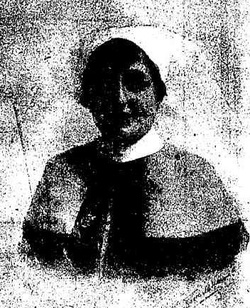
Nurse
Queen Alexandra Military Imperial Nursing Service Reserve
Born 1879 in Melbourne, Vic.
Daughter of Joseph Jacob ROSENTHAL and Martha Oken Brinski nee AVENSKI
Mother Mrs. M ROSENTHAL
Of Dickens Street, St. Kilda, Vic.
Enlisted 15 December 1915
Embarked from Australia 18 December 1915
Arrived in UK 10 February 1916
Posted 10 February 1916 to France
Posted to Abberville, 33 CCS, 24 General Hospital, 26 General Hospital, 54 CCS, 6 CS, 4 CCS, 33 CCS, 12 Stationary Hospital, 33 CCS, 30 CCS, 33 CCS, 4 Stationary Hospital
'Miss Rosenthal rejoined this unit 10 June 1918. She had charge of the Acute Medical Ward when we first opened. I hav always found her very cheerful and willing. She kept her Ward very well. when the C.C.S. opened for Surgical Cases Miss Rosenthal was attached to the Surgical Specialist Team as an 'Anaesthesist'. The Surgical Sepcialist speaks very lighly of her work and considers her very capable and fitted for her work as an 'Anaesthesist'. I consider her very suitable for work in a C.C.S.'
Awarded Military Medal
Awarded Royal Red Cross
Transferred to UK 19 January 1919
Posted to the Royal Victoria Hospital 09 February 1919 but did not join
Resigned appointment due to 'Private and Financial Affairs in Austrlaia' 09 May 1919
'My reasons for tendering my resignation are - urgent private & financial affairs in Australia which have become complicated during my prolonged absence having left Australia on December 17th 1915. My financial & business interests are vested in a private hospital of which I am joint partner with Miss I K Jobson, any further continued absence will I fear entail serious loss.'
Served 3 years and 33 days
Returned to Australia per 'St Albans' departing London 06 April 1919
Did not marry
Died 04 October 1930 in Vic.
Late of Melbourne, Vic.
Buried Brighton Cemetery, Vic. Section H, Row 05, Plot 87.1
Read more here
A JEWISH NURSE WITH THE ALLIES.
SISTER LEAH ROSENTHAL DECORATED.
Miss Leah Rosenthal, who is in her fourth, year of active service, has been awarded the Royal Red Cross.
On more than one occasion she has been recommended for honours by her commanding officer and matron for heroic conduct at casualty stations under shell fire. She was one of the first Victorian army nurses entrusted with the administering of anaesthetics; a small group of them being specially trained for this responsible work.
For some time she has been attached to a medical unit deputed to follow up the advance of the Allies. This has given her the opportunity of observing at close quarters many of the places where the Hun has been in occupation and left evidence of his vandalism.
Writing six days before the signing of the armistice to Mrs. M. Rosenthal, her mother, at Dickens-street, St. Kilda, Sister Rosenthal describes a visit she made with some other nurses for afternoon tea at the quarters of the Australian Light Horse in a small French village.
"This poor little village," wrote the Australian Sister, "Is very much knocked about. Many, of the insides of the houses are ripped to pieces, and one sees oddments of furniture scattered all over the place. The 4th Australian Light Horsemen had their mess in what was once a little terrace of brick cottages. The place, had been battered about, but the men had made it fairly comfortable. They discovered plenty of wood and coal left behind by the Boche, and when we visited them they had a cheery fire burning, and gave us nice afternoon, tea with hot scones
and cakes, all made by one of the Aussies. We drank out of basins and tin mugs.
While we were enjoying our tea in walked an old Frenchman and his daughter. This was his home, which he had not seen for four years, owing to the German occupation. They went about the room and touched the furniture most lovingly. It was pathetic to see them. Especially glad were they to find the fireplace, mirror and their heirloom cupboard undamaged."
"In most of these French houses, no matter how humble, there is a fine old cupboard. In a little, home where I was once billeted there was a cupboard more than 200 years old. The owner was only a poor peasant woman, but she would not part with it, although offered large sums for it."
"One of these cupboards was included in this home where the Australian soldier had settled, also, a fine wardrobe and two polished tables. The Light Horse were ordered to advance the next day, so the rightful owner was able to take possession much sooner than he expected. The Huns had been ejected only a few weeks previously."
"I left very soon afterwards for a small town near Valenclennes. It is most interesting following up the advance like this and being attached to the first casualty clearing stations to come to these parts. In this place the main bridge across the canal had been blown up by the gentle Hun, so we had to cross on one that our troops had thrown across. The town had the French flag flying from nearly every window."
"The scene was very gay, but it was terrible to see the white, thin faces of the people, especially the little children. These people had been four years in the power, of the Germans, and had never tasted meat, all that time, just bread and grease, and vegetables sometimes. "...
"The experience has left its mark on. them. The Field Ambulance men who arrived before us saw most pathetic sights. The whole population was ravenous. Those who were given food simply bolted it down their throats; without any attempt at mastication. One man ate steadily for two hours and even then was not satisfied. Our soldiers had to give him another, meal. When they first arrived our men saw women cutting up dead horses and fighting in the streets for the flesh."
"We are quartered in a large school. It has been a magnificent building; but when we took possession it was in a dreadful state of filth and neglect. The Huns had cut off the water supply, destroyed the drainage pipes, and battered part of the building with bombs. The engineers came along before some of the bombs exploded, and so saved the place from, being entirely demolished. In a few days we had it converted into a clean and comfortable hospital."
Sister Rosenthal is a trainee of the Alfred Hospital, St. Kilda-road, Melbourne, and before volunteering for active service with Miss Isabel Jobson managed "Windarra" private hospital, Williams-road, Toorak. She and Miss Jobson enlisted on the same date, and have never been separated all the time they have been on active service. Sister Rosenthal is now with the 33rd Casualty Clearing Station, and has been continuously right up to the end of the war with the first army of occupation, and is, we believe, the first Jewish nurse in Australia to gain the decoration of the Royal Red Cross.
In a letter received last month Sister Rosenthal refers to her having attended her second Yom Kippur service on the battlefield, being the only woman present on each occasion. Padre Bamett officiated, and had to improvise biscuit tins, with a curtain in front for the Ark to hold the Scrolls of the Law. Sister Rosenthal states that this, how
over, did not in any way militate against the impressiveness of the occasion nor the service.
Jewish Herald Friday 24 January 1919 page 6
Queen Alexandra Military Imperial Nursing Service Reserve
Born 1879 in Melbourne, Vic.
Daughter of Joseph Jacob ROSENTHAL and Martha Oken Brinski nee AVENSKI
Mother Mrs. M ROSENTHAL
Of Dickens Street, St. Kilda, Vic.
Enlisted 15 December 1915
Embarked from Australia 18 December 1915
Arrived in UK 10 February 1916
Posted 10 February 1916 to France
Posted to Abberville, 33 CCS, 24 General Hospital, 26 General Hospital, 54 CCS, 6 CS, 4 CCS, 33 CCS, 12 Stationary Hospital, 33 CCS, 30 CCS, 33 CCS, 4 Stationary Hospital
'Miss Rosenthal rejoined this unit 10 June 1918. She had charge of the Acute Medical Ward when we first opened. I hav always found her very cheerful and willing. She kept her Ward very well. when the C.C.S. opened for Surgical Cases Miss Rosenthal was attached to the Surgical Specialist Team as an 'Anaesthesist'. The Surgical Sepcialist speaks very lighly of her work and considers her very capable and fitted for her work as an 'Anaesthesist'. I consider her very suitable for work in a C.C.S.'
Awarded Military Medal
Awarded Royal Red Cross
Transferred to UK 19 January 1919
Posted to the Royal Victoria Hospital 09 February 1919 but did not join
Resigned appointment due to 'Private and Financial Affairs in Austrlaia' 09 May 1919
'My reasons for tendering my resignation are - urgent private & financial affairs in Australia which have become complicated during my prolonged absence having left Australia on December 17th 1915. My financial & business interests are vested in a private hospital of which I am joint partner with Miss I K Jobson, any further continued absence will I fear entail serious loss.'
Served 3 years and 33 days
Returned to Australia per 'St Albans' departing London 06 April 1919
Did not marry
Died 04 October 1930 in Vic.
Late of Melbourne, Vic.
Buried Brighton Cemetery, Vic. Section H, Row 05, Plot 87.1
Read more here
A JEWISH NURSE WITH THE ALLIES.
SISTER LEAH ROSENTHAL DECORATED.
Miss Leah Rosenthal, who is in her fourth, year of active service, has been awarded the Royal Red Cross.
On more than one occasion she has been recommended for honours by her commanding officer and matron for heroic conduct at casualty stations under shell fire. She was one of the first Victorian army nurses entrusted with the administering of anaesthetics; a small group of them being specially trained for this responsible work.
For some time she has been attached to a medical unit deputed to follow up the advance of the Allies. This has given her the opportunity of observing at close quarters many of the places where the Hun has been in occupation and left evidence of his vandalism.
Writing six days before the signing of the armistice to Mrs. M. Rosenthal, her mother, at Dickens-street, St. Kilda, Sister Rosenthal describes a visit she made with some other nurses for afternoon tea at the quarters of the Australian Light Horse in a small French village.
"This poor little village," wrote the Australian Sister, "Is very much knocked about. Many, of the insides of the houses are ripped to pieces, and one sees oddments of furniture scattered all over the place. The 4th Australian Light Horsemen had their mess in what was once a little terrace of brick cottages. The place, had been battered about, but the men had made it fairly comfortable. They discovered plenty of wood and coal left behind by the Boche, and when we visited them they had a cheery fire burning, and gave us nice afternoon, tea with hot scones
and cakes, all made by one of the Aussies. We drank out of basins and tin mugs.
While we were enjoying our tea in walked an old Frenchman and his daughter. This was his home, which he had not seen for four years, owing to the German occupation. They went about the room and touched the furniture most lovingly. It was pathetic to see them. Especially glad were they to find the fireplace, mirror and their heirloom cupboard undamaged."
"In most of these French houses, no matter how humble, there is a fine old cupboard. In a little, home where I was once billeted there was a cupboard more than 200 years old. The owner was only a poor peasant woman, but she would not part with it, although offered large sums for it."
"One of these cupboards was included in this home where the Australian soldier had settled, also, a fine wardrobe and two polished tables. The Light Horse were ordered to advance the next day, so the rightful owner was able to take possession much sooner than he expected. The Huns had been ejected only a few weeks previously."
"I left very soon afterwards for a small town near Valenclennes. It is most interesting following up the advance like this and being attached to the first casualty clearing stations to come to these parts. In this place the main bridge across the canal had been blown up by the gentle Hun, so we had to cross on one that our troops had thrown across. The town had the French flag flying from nearly every window."
"The scene was very gay, but it was terrible to see the white, thin faces of the people, especially the little children. These people had been four years in the power, of the Germans, and had never tasted meat, all that time, just bread and grease, and vegetables sometimes. "...
"The experience has left its mark on. them. The Field Ambulance men who arrived before us saw most pathetic sights. The whole population was ravenous. Those who were given food simply bolted it down their throats; without any attempt at mastication. One man ate steadily for two hours and even then was not satisfied. Our soldiers had to give him another, meal. When they first arrived our men saw women cutting up dead horses and fighting in the streets for the flesh."
"We are quartered in a large school. It has been a magnificent building; but when we took possession it was in a dreadful state of filth and neglect. The Huns had cut off the water supply, destroyed the drainage pipes, and battered part of the building with bombs. The engineers came along before some of the bombs exploded, and so saved the place from, being entirely demolished. In a few days we had it converted into a clean and comfortable hospital."
Sister Rosenthal is a trainee of the Alfred Hospital, St. Kilda-road, Melbourne, and before volunteering for active service with Miss Isabel Jobson managed "Windarra" private hospital, Williams-road, Toorak. She and Miss Jobson enlisted on the same date, and have never been separated all the time they have been on active service. Sister Rosenthal is now with the 33rd Casualty Clearing Station, and has been continuously right up to the end of the war with the first army of occupation, and is, we believe, the first Jewish nurse in Australia to gain the decoration of the Royal Red Cross.
In a letter received last month Sister Rosenthal refers to her having attended her second Yom Kippur service on the battlefield, being the only woman present on each occasion. Padre Bamett officiated, and had to improvise biscuit tins, with a curtain in front for the Ark to hold the Scrolls of the Law. Sister Rosenthal states that this, how
over, did not in any way militate against the impressiveness of the occasion nor the service.
Jewish Herald Friday 24 January 1919 page 6
|
NURSE LEAH ROSENTHAL.
Sister Leah Rosenthal (sister of Lieutenant Samuel Rosenthal, who was killed in action at Polylgon Wood on 25th August), left Melbourne two years ago for London, having joined the British Nursing Staff, and is now one of the Queen Alexandra nurses. She has been seventeen months at a Casualty Clearing " Station, and latterly in a hospital which has often been bombarded. Her family this week received a quantity of war trophies of used shot and shell, amongst which was a very heavy piece of shell, which she labelled—"Piece of shell that hit this hospital, and wrecked the church." Amongst them also was the cap of a bomb which fell within three yards of her, in the hospital compound. Sister Rosenthal is one of the five nurses, retained at this most dangerous spot, the patients and rest of the staff being removed to a safer place. She also mentions in her letters how she wears a gas mask on her shoulders in case of emergency when crossing the hospital compound. She and Miss Jobson, who ran Windarra Hospital, Willliams road, Toorak, have never been separated since they left Melbourne, and both speak of " the honour of being retained in that most dangerous spot, where they are at present in France. Jewish Herald Friday 30 November 1917 page 8 |
AUSTRALIAN NURSES DECORATED.
In the Melbourne Herald of May 21, there is rather, a pretty story of the friendship or two Australian nurses who left this country two and a half years ago in a nursing unit for the front. These two ladies had struck up a friendship as probationers in a Melbourne Hospital and subsequently took a private Hospital in Toorak. They left Australia together and have not been separated since. They were both recommended tor honours by their commanding officer and matron for heroic conduct under are at a casualty clearing station, but only one was decorated. They worked together for a year at one casualty clearing station which was shelled frequently and were among the first Australian nurses to be entrusted with the administration of anaesthetics. They were chosen amongst others from hundreds of nurses from all over the British Empire after a short course in this branch of the work.
The nurse - or sister as the soldiers always know them - who received the Royal red Cross decoration was Miss
Jobson, and her bosom friend is Miss Leah Rosenthal, sister of Mr. M. Rosenthal of Renmark. On the authority of The Bulletin and another paper we learn that sister Rosenthal has since been recommended again for decoration and now wears both the Military Medal and the Royal Red Cross decoration. In a letter home she speaks or portion or a shell falling near her, that her friend informs the family that pieces of a shell actually passed through her dress without wounding her. Sister Rosenthal has sent some of that shell home.
No one rejoices more to hear of honours being conferred upon our nursing sisters than returned soldiers who know from personal experience their courage and devotion to duty under fire and elsewhere. Sister Rosenthal comes from a family that has done its duty splendidly to the Empire-Lieut. S. Rosenthal, a brother, was killed leading his men in a gallant counter attack and Dr. Rosenthal, another brother, has just returned from the front to his practice at Camberwell, Melbourne.
Murray Pioneer and Australian River Record Friday 14 June 1918 Page 6
In the Melbourne Herald of May 21, there is rather, a pretty story of the friendship or two Australian nurses who left this country two and a half years ago in a nursing unit for the front. These two ladies had struck up a friendship as probationers in a Melbourne Hospital and subsequently took a private Hospital in Toorak. They left Australia together and have not been separated since. They were both recommended tor honours by their commanding officer and matron for heroic conduct under are at a casualty clearing station, but only one was decorated. They worked together for a year at one casualty clearing station which was shelled frequently and were among the first Australian nurses to be entrusted with the administration of anaesthetics. They were chosen amongst others from hundreds of nurses from all over the British Empire after a short course in this branch of the work.
The nurse - or sister as the soldiers always know them - who received the Royal red Cross decoration was Miss
Jobson, and her bosom friend is Miss Leah Rosenthal, sister of Mr. M. Rosenthal of Renmark. On the authority of The Bulletin and another paper we learn that sister Rosenthal has since been recommended again for decoration and now wears both the Military Medal and the Royal Red Cross decoration. In a letter home she speaks or portion or a shell falling near her, that her friend informs the family that pieces of a shell actually passed through her dress without wounding her. Sister Rosenthal has sent some of that shell home.
No one rejoices more to hear of honours being conferred upon our nursing sisters than returned soldiers who know from personal experience their courage and devotion to duty under fire and elsewhere. Sister Rosenthal comes from a family that has done its duty splendidly to the Empire-Lieut. S. Rosenthal, a brother, was killed leading his men in a gallant counter attack and Dr. Rosenthal, another brother, has just returned from the front to his practice at Camberwell, Melbourne.
Murray Pioneer and Australian River Record Friday 14 June 1918 Page 6
Sister Jobson, R.R.C., and Sister Leah Rosenthal, R.R.C. have settled down to peace-time occupation, and have taken the private hospital known as "St.Luke's," Queen's-road, which will in future be known as Vimy House Private Hospital.
Table Talk Thursday 19 August 1920 page 35
The death occurred recently of Sister Leah Rosenthal, R.R.C., part owner of Vimy House, Queen's Road, Melbourne.
Daily Advertiser Wagga Wagga Friday 17 October 1930 page 2
Table Talk Thursday 19 August 1920 page 35
The death occurred recently of Sister Leah Rosenthal, R.R.C., part owner of Vimy House, Queen's Road, Melbourne.
Daily Advertiser Wagga Wagga Friday 17 October 1930 page 2
ROSS, Angela Mary
Staff Nurse
AANS
Born 12 August 1885 in Canterbury, NSW
Daughter of Robert Mander ROSS and Eleanor Lucy nee BURRETT
Sister to Robert Noel ROSS
Address Suva, Fiji
Age 30 years
(Angela Mary Ross is the great granddaughter of David Jones--as in David Jones & Co--and Jane Mander. Another set of great grandparents are the Rev Dr Robert Ross and Marina Haldon. Rev Dr Robert Ross was instrumental in founding the Pitt Street Congregational Church in Sydney.)
Training 3 years Perth Hospital
Enlisted 26 August 1915
Service in Egypt
Returned to Australia per “Karoola” 04 December 1915 - On Duty
Medically unfit (Neurasthenia)
Appointment Terminated 24 March 1916
Angela Mary Ross graduated from Sydney University in 1928 as a medical doctor.
She did not marry
Died in the Repat Hospital, Concord, NSW on the 8 June 1976.
Supplementary information supplied by Ms Sue Reid
AANS
Born 12 August 1885 in Canterbury, NSW
Daughter of Robert Mander ROSS and Eleanor Lucy nee BURRETT
Sister to Robert Noel ROSS
Address Suva, Fiji
Age 30 years
(Angela Mary Ross is the great granddaughter of David Jones--as in David Jones & Co--and Jane Mander. Another set of great grandparents are the Rev Dr Robert Ross and Marina Haldon. Rev Dr Robert Ross was instrumental in founding the Pitt Street Congregational Church in Sydney.)
Training 3 years Perth Hospital
Enlisted 26 August 1915
Service in Egypt
Returned to Australia per “Karoola” 04 December 1915 - On Duty
Medically unfit (Neurasthenia)
Appointment Terminated 24 March 1916
Angela Mary Ross graduated from Sydney University in 1928 as a medical doctor.
She did not marry
Died in the Repat Hospital, Concord, NSW on the 8 June 1976.
Supplementary information supplied by Ms Sue Reid
ROSS, Clara Louisa
|
Matron
AANS Born 1874 IN French Island, Vic. Birth registered at Tyabb, Vic. Daughter of John ROSS and Mary Ann nee CROCKET Daughter of Margaret C ROSS Age 40 years Training Melbourne Hospital Enlisted 04 November 1914 Embarked 28 November 1914 Service in Egypt, France, England Promoted to Head Sister 07 July 1916 Promoted to Matron 30 November 1917 Awarded Royal Red Cross 1st Class on 21 June 1918 Awarded an O.B.E. 03 June1919 Returned to Australia 22 August 1919 per “Anchises” Appointment terminated 11 January 1920 Married Richard Arthur JENKIN Died 1960 in Vic. Photograph Table Talk Thursday 10 December 1914 page 22 Punch Thursday 03 December 1914 page 26 |
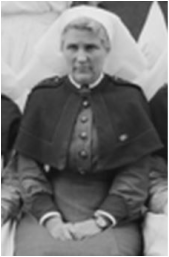
Nursing Sister 1st A.I.F. dies
The death took place in the Alfred Hospital on Saturday after a short illness of Matron C. L. Ross,
O.B.E., R.R.C., a member of the Australian Army Nursing Service during World War I. Miss Ross
belonged to that rapidly diminishing band of senior nurses who were with the first contingent
of the A.I.F. in December, 1914.
Miss Ross trained at the Melbourne Hospital. She served with distinction in Egypt and in France.
In the final year of the war, Sister Ross was raised to the rank of Matron, and was placed in charge
of the nursing section of the Australian Hospital at Harefield,in England, and subsequently at
Dartford, in Kent.
Her war services were recognised by the award of the R.R.C. (first-class) in 1917, and the O.B.E. in 1918.
After demobilisation and some years of special private nursing in England, Miss Ross returned to Australia and became in turn Matron of the Castlemaine Hospital and matron of the Geelong Hospital.
She remained at Geelong until her retirement in 1938.
The Argus Tuesday 23 December 1952 page 4
The death took place in the Alfred Hospital on Saturday after a short illness of Matron C. L. Ross,
O.B.E., R.R.C., a member of the Australian Army Nursing Service during World War I. Miss Ross
belonged to that rapidly diminishing band of senior nurses who were with the first contingent
of the A.I.F. in December, 1914.
Miss Ross trained at the Melbourne Hospital. She served with distinction in Egypt and in France.
In the final year of the war, Sister Ross was raised to the rank of Matron, and was placed in charge
of the nursing section of the Australian Hospital at Harefield,in England, and subsequently at
Dartford, in Kent.
Her war services were recognised by the award of the R.R.C. (first-class) in 1917, and the O.B.E. in 1918.
After demobilisation and some years of special private nursing in England, Miss Ross returned to Australia and became in turn Matron of the Castlemaine Hospital and matron of the Geelong Hospital.
She remained at Geelong until her retirement in 1938.
The Argus Tuesday 23 December 1952 page 4
ROSS, Janet
Staff Nurse
AANS
Born Ballarat, Vic
Daughter of Mr. John ROSS
Age 33 years
Training Maryborough Hospital
Enlisted 15 June 1917
Embarked 30 June 1917 in Melbourne per “Somali”
Service in India
Returned to Australia per “Eastern” 13 April 1919
Appointment Terminated 12 February 1920
Married Richard Arthur JENKINS
JENKIN—ROSS.—On the 1st January, 1920, at the residence of the bride's parents, by the Rev. D. Macrae Stewart (late A.I.F.), Richard Arthur late B.I.F.), son of Richard Hugh and Betsy Jenkin, Cornwall, England, to Janet (late A.A.N.S., A.I.F.), eldest daughter of John and Mary Ross, of "Inverleigh," Westgarth street, East Malvern.
First child born 14 October 1920 at Waratah, Tas.
AANS
Born Ballarat, Vic
Daughter of Mr. John ROSS
Age 33 years
Training Maryborough Hospital
Enlisted 15 June 1917
Embarked 30 June 1917 in Melbourne per “Somali”
Service in India
Returned to Australia per “Eastern” 13 April 1919
Appointment Terminated 12 February 1920
Married Richard Arthur JENKINS
JENKIN—ROSS.—On the 1st January, 1920, at the residence of the bride's parents, by the Rev. D. Macrae Stewart (late A.I.F.), Richard Arthur late B.I.F.), son of Richard Hugh and Betsy Jenkin, Cornwall, England, to Janet (late A.A.N.S., A.I.F.), eldest daughter of John and Mary Ross, of "Inverleigh," Westgarth street, East Malvern.
First child born 14 October 1920 at Waratah, Tas.
ROSS-KING, Alys
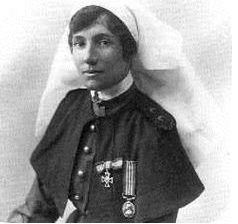
Staff Nurse
AANS
Born 05 August 1891 at Ballarat, Vic.
Daughter of Archibald ROSS-KING and Henrietta nee WARD
Married Sydney Theodore APPLEFORD on 20 August 1919 at Wesley Church, Melbourne
Died on 17 August 1968 in Cronulla, NSW
Buried in The Fawkner Cemetery, Victoria.
Alys Ross was born in the Victorian town of Ballarat, on 5 August 1891. She was of hardy
Scottish stock and while she was still a toddler, her father had moved the family to Perth
in search of a better life. With the onset of war, Sister Ross enlisted in the Australian
Imperial Force in November 1914, Alice was allocated to the 1st Australian General Hospital
(AGH) and sailed for Egypt on 21 November 1914 aboard the hospital ship Kyarra. The 1st Australian General Hospital was based in the Cairo suburb of Heliopolis and the nursing staff was kept busy with a constant stream of patients emanating from the AIF desert training camps at Mena. During her AIF service she used the surname Ross-King and changed the spelling of her Christian name to Alice. Her mother was extremely upset with her daughter’s decision to go to war. Alice was all the family she had left and the thought that her only child might be killed or injured weighed heavily on Mrs Ross’s mind.
In November 1917, Alice returned to Rouen, France, where she was promoted to Head Sister, 1AGH. Accompanied by a number of other sisters and nurses, Alice moved to an advanced dressing station just behind the front lines.
One night, only five days after her arrival, Alice was making her way back to her tent at the end of her shift. As she followed a young orderly along the duckboards, she heard the high-pitched sound of approaching aircraft. Staring skyward, she could see the grey outline of the planes and as they came closer she could distinguish the bold crosses on the wings. She knew that the hospital was clearly marked with large red crosses but, despite this, the German pilots seemed hell-bent on attacking. She heard the whistle of falling bombs just before one of the missiles exploded directly in front of her, knocking her to the ground. Regaining her senses, Alice looked around for the orderly but could not see him. Realising the enormity of the situation, she rushed back to her patients. The deadly projectiles were now bursting amid the buildings and tents. As she ran to the wards, she found what was left of the pneumonia ward tent.
As she made her way back to her tent, she heard the feeble, anguished moans of wounded men. She searched until she found the source—53 badly wounded German prisoners who had been all but forgotten for the past three days. ‘Doctor! Doctor! Come quickly!’ she called frantically.
Alice was twice Mentioned in Despatches and she was awarded the Military Medal 28th November 1917 and the Royal Red Cross, 2nd Class, in the King’s Birthday Honours of 1918.
Alice Appleford (Ross) died on 17 August 1968 in Cronulla, NSW & is buried in The Fawkner Cemetery, Victoria.
Courtesy of Joy Dalgleish
AANS
Born 05 August 1891 at Ballarat, Vic.
Daughter of Archibald ROSS-KING and Henrietta nee WARD
Married Sydney Theodore APPLEFORD on 20 August 1919 at Wesley Church, Melbourne
Died on 17 August 1968 in Cronulla, NSW
Buried in The Fawkner Cemetery, Victoria.
Alys Ross was born in the Victorian town of Ballarat, on 5 August 1891. She was of hardy
Scottish stock and while she was still a toddler, her father had moved the family to Perth
in search of a better life. With the onset of war, Sister Ross enlisted in the Australian
Imperial Force in November 1914, Alice was allocated to the 1st Australian General Hospital
(AGH) and sailed for Egypt on 21 November 1914 aboard the hospital ship Kyarra. The 1st Australian General Hospital was based in the Cairo suburb of Heliopolis and the nursing staff was kept busy with a constant stream of patients emanating from the AIF desert training camps at Mena. During her AIF service she used the surname Ross-King and changed the spelling of her Christian name to Alice. Her mother was extremely upset with her daughter’s decision to go to war. Alice was all the family she had left and the thought that her only child might be killed or injured weighed heavily on Mrs Ross’s mind.
In November 1917, Alice returned to Rouen, France, where she was promoted to Head Sister, 1AGH. Accompanied by a number of other sisters and nurses, Alice moved to an advanced dressing station just behind the front lines.
One night, only five days after her arrival, Alice was making her way back to her tent at the end of her shift. As she followed a young orderly along the duckboards, she heard the high-pitched sound of approaching aircraft. Staring skyward, she could see the grey outline of the planes and as they came closer she could distinguish the bold crosses on the wings. She knew that the hospital was clearly marked with large red crosses but, despite this, the German pilots seemed hell-bent on attacking. She heard the whistle of falling bombs just before one of the missiles exploded directly in front of her, knocking her to the ground. Regaining her senses, Alice looked around for the orderly but could not see him. Realising the enormity of the situation, she rushed back to her patients. The deadly projectiles were now bursting amid the buildings and tents. As she ran to the wards, she found what was left of the pneumonia ward tent.
As she made her way back to her tent, she heard the feeble, anguished moans of wounded men. She searched until she found the source—53 badly wounded German prisoners who had been all but forgotten for the past three days. ‘Doctor! Doctor! Come quickly!’ she called frantically.
Alice was twice Mentioned in Despatches and she was awarded the Military Medal 28th November 1917 and the Royal Red Cross, 2nd Class, in the King’s Birthday Honours of 1918.
Alice Appleford (Ross) died on 17 August 1968 in Cronulla, NSW & is buried in The Fawkner Cemetery, Victoria.
Courtesy of Joy Dalgleish

Awarded Royal Red Cross 2nd Class
Date of Commonwealth of Australia Gazette: 7 November 1918
Location in Commonwealth of Australia Gazette: Page 2111, position 125
Date of London Gazette: 3 June 1918
Location in London Gazette: Page 6475, position 4
Date of Commonwealth of Australia Gazette: 7 November 1918
Location in Commonwealth of Australia Gazette: Page 2111, position 125
Date of London Gazette: 3 June 1918
Location in London Gazette: Page 6475, position 4

Awarded Military Medal
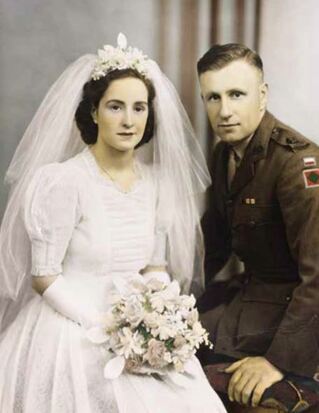
Alice Ross-King (1891-1968), civilian and army nurse, was born on 5 August 1891 at Ballarat, Victoria, daughter of Archibald Ross King, storekeeper, and his wife Henrietta, née Ward. Baptised Alys Ross, she normally used the more common spelling of her first given name. The family moved to Perth when she was very young. There Archibald King and his two sons were drowned in an accident on the Swan River; soon after, Alice and her mother settled in Melbourne.
Although a Protestant, Alice King was educated first at the Academy of Mary Immaculate (Convent of Mercy), Fitzroy, and later at Presbyterian Ladies' College. Not being old enough to begin nursing training, she worked for some time assisting the matron of the Austin Hospital, Melbourne, with general duties. During a typhoid epidemic she helped staff at the Alfred Hospital and stayed on to start training. Having gained her certificate, she remained there, becoming sister, night superintendent and acting matron. Before World War I Alice King was a theatre sister and in charge of a private hospital in Collins Street.
She enlisted as a staff nurse in the Australian Army Nursing Service, Australian Imperial Force, on 5 November 1914; her surname was hyphenated to Ross-King to distinguish her from another Alice King in the A.A.N.S. She embarked from Brisbane on 21 November with the 1st Australian General Hospital, bound for Egypt. Her appointment as sister, A.A.N.S., was effective from that date. On arrival in Egypt the 1st A.G.H. was established at Heliopolis, Cairo. Soon after, Alice Ross-King and a group of nurses were sent to Suez to occupy an evacuated French convent orphanage as a clearing hospital for casualties from Gallipoli. Later in 1915 she returned to Australia on transport duties, nursing the wounded; she later returned to Egypt with a troopship carrying reinforcements.
In April 1916 the 1st A.G.H. was sent to France and established at Rouen. Sister Ross-King remained with it throughout the Somme offensive until detached to the 10th Stationary Hospital on 7 June 1917 at St Omer. On 17 July she was sent forward to the 2nd Australian Casualty Clearing Station close to the trenches at Trois Arbres near Armentières. On the night of 22 July the C.C.S. was bombed. Although close to the railway line the hospital had never been attacked before and Ross-King was following an orderly along the duckboards when five bombs hit the hospital, the first falling directly ahead of her. In her diary she describes the horror and carnage that followed and it was for her bravery during the attack that she was awarded the Military Medal. The citation praised her 'great coolness and devotion to duty' during that night. Ross-King was one of only seven nurses of the A.A.N.S. to be awarded the Military Medal during World War I. The ribbon to her medal was presented a month later by General Sir William Birdwood.
Bombing raids continued on the C.C.S. during the next few weeks and the 3rd battle of Ypres was taxing for the staff; Alice Ross-King wrote in her diary, 'The Last Post is being played nearly all day at the cemetery next door to the hospital. So many deaths'. On 18 November she was posted back to the 1st A.G.H. at Rouen. On Christmas Day she was mentioned in dispatches and on 31 May 1918 was awarded the Associate Royal Red Cross.
The 1st A.G.H. transferred to England on 9 January 1919 and that month Ross-King embarked for return to Australia. Her A.I.F. appointment ended on 17 September. During the voyage home she had met a doctor, Sydney Theodore Appleford. They were married on 20 August 1919 at Wesley Church, Melbourne, and settled at Lang Lang, South Gippsland; they had two daughters and two sons. According to her daughters, Alice Appleford was a very private person and never talked about her war experiences.
In the late 1930s she trained Volunteer Aid Detachments in the Gippsland area. By 1940 she and her family had moved back to Melbourne, living at Essendon. She enlisted for full-time duty with the V.A.D.s and her husband was commissioned as a medical officer in the army. By 1942 the V.A.D.s had developed into the Australian Army Women's Medical Services and Alice Appleford was commissioned as a major and appointed senior assistant controller for Victoria. Untiring in her devotion to duty and hard work, with responsibility for some 2000 servicewomen, her organizing skills had great impact on fund-raising activities during World War II. She was fully committed in assisting Red Cross and Service charities, supporting war widows and children and demonstrating concern for the well-being of members of the A.A.W.M.S.
Alice Appleford was awarded the Florence Nightingale medal in 1949 by the International Red Cross. Her citation is descriptive of her character: 'no one who came in contact with Major Appleford could fail to recognise her as a leader of women. Her sense of duty, her sterling solidity of character, her humanity, sincerity, and kindliness of heart set for others a very high example'.
Survived by her four children, Alice Appleford died on 17 August 1968 at Cronulla, Sydney, and was buried in the Presbyterian section of Fawkner cemetery, Melbourne. Her husband had predeceased her in 1958. An annual award is presented to a serving member of the Royal Australian Army Nursing Corps by the Ex-A.A.W.M.S. Association to perpetuate her memory.
by Lorna M Finnie
This article was published in Australian Dictionary of Biography, Volume 11, (MUP), 1988
http://adb.anu.edu.au/biography/ross-king-alice-8276
Read more here
Although a Protestant, Alice King was educated first at the Academy of Mary Immaculate (Convent of Mercy), Fitzroy, and later at Presbyterian Ladies' College. Not being old enough to begin nursing training, she worked for some time assisting the matron of the Austin Hospital, Melbourne, with general duties. During a typhoid epidemic she helped staff at the Alfred Hospital and stayed on to start training. Having gained her certificate, she remained there, becoming sister, night superintendent and acting matron. Before World War I Alice King was a theatre sister and in charge of a private hospital in Collins Street.
She enlisted as a staff nurse in the Australian Army Nursing Service, Australian Imperial Force, on 5 November 1914; her surname was hyphenated to Ross-King to distinguish her from another Alice King in the A.A.N.S. She embarked from Brisbane on 21 November with the 1st Australian General Hospital, bound for Egypt. Her appointment as sister, A.A.N.S., was effective from that date. On arrival in Egypt the 1st A.G.H. was established at Heliopolis, Cairo. Soon after, Alice Ross-King and a group of nurses were sent to Suez to occupy an evacuated French convent orphanage as a clearing hospital for casualties from Gallipoli. Later in 1915 she returned to Australia on transport duties, nursing the wounded; she later returned to Egypt with a troopship carrying reinforcements.
In April 1916 the 1st A.G.H. was sent to France and established at Rouen. Sister Ross-King remained with it throughout the Somme offensive until detached to the 10th Stationary Hospital on 7 June 1917 at St Omer. On 17 July she was sent forward to the 2nd Australian Casualty Clearing Station close to the trenches at Trois Arbres near Armentières. On the night of 22 July the C.C.S. was bombed. Although close to the railway line the hospital had never been attacked before and Ross-King was following an orderly along the duckboards when five bombs hit the hospital, the first falling directly ahead of her. In her diary she describes the horror and carnage that followed and it was for her bravery during the attack that she was awarded the Military Medal. The citation praised her 'great coolness and devotion to duty' during that night. Ross-King was one of only seven nurses of the A.A.N.S. to be awarded the Military Medal during World War I. The ribbon to her medal was presented a month later by General Sir William Birdwood.
Bombing raids continued on the C.C.S. during the next few weeks and the 3rd battle of Ypres was taxing for the staff; Alice Ross-King wrote in her diary, 'The Last Post is being played nearly all day at the cemetery next door to the hospital. So many deaths'. On 18 November she was posted back to the 1st A.G.H. at Rouen. On Christmas Day she was mentioned in dispatches and on 31 May 1918 was awarded the Associate Royal Red Cross.
The 1st A.G.H. transferred to England on 9 January 1919 and that month Ross-King embarked for return to Australia. Her A.I.F. appointment ended on 17 September. During the voyage home she had met a doctor, Sydney Theodore Appleford. They were married on 20 August 1919 at Wesley Church, Melbourne, and settled at Lang Lang, South Gippsland; they had two daughters and two sons. According to her daughters, Alice Appleford was a very private person and never talked about her war experiences.
In the late 1930s she trained Volunteer Aid Detachments in the Gippsland area. By 1940 she and her family had moved back to Melbourne, living at Essendon. She enlisted for full-time duty with the V.A.D.s and her husband was commissioned as a medical officer in the army. By 1942 the V.A.D.s had developed into the Australian Army Women's Medical Services and Alice Appleford was commissioned as a major and appointed senior assistant controller for Victoria. Untiring in her devotion to duty and hard work, with responsibility for some 2000 servicewomen, her organizing skills had great impact on fund-raising activities during World War II. She was fully committed in assisting Red Cross and Service charities, supporting war widows and children and demonstrating concern for the well-being of members of the A.A.W.M.S.
Alice Appleford was awarded the Florence Nightingale medal in 1949 by the International Red Cross. Her citation is descriptive of her character: 'no one who came in contact with Major Appleford could fail to recognise her as a leader of women. Her sense of duty, her sterling solidity of character, her humanity, sincerity, and kindliness of heart set for others a very high example'.
Survived by her four children, Alice Appleford died on 17 August 1968 at Cronulla, Sydney, and was buried in the Presbyterian section of Fawkner cemetery, Melbourne. Her husband had predeceased her in 1958. An annual award is presented to a serving member of the Royal Australian Army Nursing Corps by the Ex-A.A.W.M.S. Association to perpetuate her memory.
by Lorna M Finnie
This article was published in Australian Dictionary of Biography, Volume 11, (MUP), 1988
http://adb.anu.edu.au/biography/ross-king-alice-8276
Read more here
ROSSITER, Constance Anne
Staff Nurse
AANS
Born 24 February 1885 in Melbourne, Vic.
Daughter of James ROSSITER and Sarah Jane nee TAYLOR
Age 30 years
Training Melbourne Hospital
Enlisted 28 June 1918
Embarked 09 November 1918 in Sydney per “Wiltshire”
Service in India
Returned to Australia 01 December 1919 per “Medic” On Duty
Appointment Terminated 12 February 1920
Did not marry
Died 27 October 1972 in Heidelberg, Vic.
Late of South Yarra, Vic.
Cremated at Springvale Botanical Cemetery and her cremated remains were scattered
AANS
Born 24 February 1885 in Melbourne, Vic.
Daughter of James ROSSITER and Sarah Jane nee TAYLOR
Age 30 years
Training Melbourne Hospital
Enlisted 28 June 1918
Embarked 09 November 1918 in Sydney per “Wiltshire”
Service in India
Returned to Australia 01 December 1919 per “Medic” On Duty
Appointment Terminated 12 February 1920
Did not marry
Died 27 October 1972 in Heidelberg, Vic.
Late of South Yarra, Vic.
Cremated at Springvale Botanical Cemetery and her cremated remains were scattered
ROTHERHAM, Margaret Ellen
Staff Nurse
AANS
Born Margaret Helen ROTHERHAM 07 July 1888 in St. Arnaud, Vic.
Daughter of Henry John ROTHERHAM and Margaret nee REID
Age 28 years
Training St Arnaud Hospital
Enlisted 27 February 1918
Embarked 06 March 1918 in Melbourne per “Ormonde”
Service in India
Seriously ill with appendicitis and operated June 1919
Returned to Australia 17 November 1919 per “Charon”
Discharged as medically unfit (post operative pain) 28 May 1920
Worked as a nurse in South Africa.
She was married on 1 December 1925 in Durban, South Africa to William SMITH
AANS
Born Margaret Helen ROTHERHAM 07 July 1888 in St. Arnaud, Vic.
Daughter of Henry John ROTHERHAM and Margaret nee REID
Age 28 years
Training St Arnaud Hospital
Enlisted 27 February 1918
Embarked 06 March 1918 in Melbourne per “Ormonde”
Service in India
Seriously ill with appendicitis and operated June 1919
Returned to Australia 17 November 1919 per “Charon”
Discharged as medically unfit (post operative pain) 28 May 1920
Worked as a nurse in South Africa.
She was married on 1 December 1925 in Durban, South Africa to William SMITH
ROTHERY, Elizabeth
|
Staff Nurse
AANS Born Whitehaven, England Daughter of Joseph ROTHERY Enlisted 18 August 1916 Embarked 22 August 1916 Enlisted 15 January 1918 Served in Hospital Transport Corps May 1915 - September 1918 per 'Karoola' Embarked 23 January 1918 Did not marry Died 15 June 1918 in Beechworth, Victoria Buried Beechworth Cemetery C E B 419 Punch 31 August 1916 |
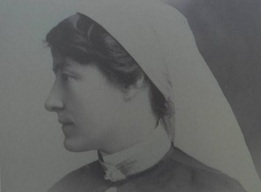 Photograph Courtesy of Faye Threlfall
WW1 Australian and New Zealand Nurses
Photograph Courtesy of Faye Threlfall
WW1 Australian and New Zealand Nurses
DEATH OF ARMY NURSE.
Military Funeral at Beechworth.
BEECHWORTH, Monday. —The death occurred at Beechworth on Saturday of Sister Elizabeth Rothery, an Australian army nurse. Sister Rothery trained for her profession
at the Beechworth Hospital, and on the outbreak of war volunteered for military duty, first
doing service at the Base Hospital, Melbourne. Later she was for eight months at Bombay,
and was then transferred to England, where she was first at a Nottingham hospital, and
later at Fairfield Hospital, London. She returned to Australia last year, and for some time
was on the nursing staff at the Caulfield Base Hospital. For the last six months she had
been on a hospital ship travelling between Australia and South Africa and Egypt. While
on leave last week she visited friends at Beechworth, and became suddenly ill with acute appendicitis, which caused her death. The funeral took place at Beechworth Cemetery yesterday, and was of a military character.
The Argus Tuesday 18 June 1918 page 6
Death of Military Nurse Rothery.
A MILITARY FUNERAL.REMARKABLE DEMONSTRATION OF ADMIRATION ANDGRIEF.[REPRINTED BY PUBLIC REQUEST.]
That the nobility of the nursing profession is popularly elevated almost to divinity in the military nurses was shown by a truly remarkable demonstration by the people of Beechworth on Sunday afternoon last. On the previous day Military Nurse Elizabeth Rothery, eldest daughter of Mr. and Mrs. Joseph Rothery, former residents of Beechworth, succumbed to appendicitis and peritonitis, after a brief illness, while on a visit to Miss Wilson, of Last street, Beechworth, with whom she had spent many a delightful holiday. Trained as a nurse at the Ovens District Hospital, from which she obtained her certificate in 1912, Nurse Rothery volunteered for war service when the war broke out, and was appointed to the hospital on St. Kilda road, and next accompanied a transport to Bombay, doing hospital duty there for six months prior to her transfer to a military hospital in Nottingham, and later to the Fairfield Hospital, London. Returning to Australia, she resumed, at Christmas time, the work amongst the sick and wounded soldiers, in which she was so greatly interested, at Caulfield Hospital, and since then had been to Capetown and Cairo and back on hospital ships. The work in an almost stifling atmosphere on the lower deck in tropical weather on the voyage from Cairo was very trying and, upon landing in Australia, Nurse Rothery was very much in need of rest. Obtaining the necessary leave she first visited her parents, and then came onto her well-loved Beechworth, where her earlier years were happily spent and which she always regarded as home. She was the guest of Miss Wilson,but this happy re-union of kindred souls had just been consummated when Miss Wilson was alarmed by the sudden illness of Miss Rothery. Dr. Skinner was immediately summoned and diagnosed appendicitis as the trouble. Then Nurse Clemens, who trained with Nurse Rothery, also came to her assistance. Owing to the patient's heart condition, operation was impossible, but every other known means of combating the trouble was employed, but all to no good purpose, and early on Saturday morning the case was seen to be hopeless. To the very last the patient's thoughts were with her soldier patients, and she passed away on Saturday afternoon. The announcement of her death caused a most profound and painful sensation, as few of Nurse Rothery's friends were even aware of her illness. Everyone knew her as a most beautiful character in every sense of the word, and her devotion to the work of alleviation of the sufferings of soldiers had not only earned the gratitude of the soldiers and their friends but the admiration of all. There was no means of public announcement, but news spread of the intention of the returned soldiers to pay their deceased sister the highest military honour in their power in the form of a military funeral. This was everywhere approved as most fitting, and on Sunday afternoon there occurred one of the most touching and remarkable demonstration of public grief and admiration in the annals of the town. There were crowds of people along the route which the funeral would take to the Beechworth cemetery, and also wherever a view of the procession could be obtained. There was also a great concourse of sorrowing people in the cemetery. When the cortege reached the cemetery the coffin, wrapped in the Union Jack, on which was laid the military uniform of the deceased nurse, was taken from the hearse and placed on the shoulders of six returned soldiers, viz., Sgt. A.Turner, Lance Corporal C. Roper, and Privates A. Hoffmann, A. Paull, W. Sargeant and Armstrong and borne shoulder high. Other returned soldiers and members of the Rifle Club with arms reversed and the Beechworth Town Band and many others, prominent among whom were the relatives of men on active service, followed. The depth to which public feeling had been stirred by this sad death was demonstrated in several most respectful actions by the assembled people. When the coffin bearers were still afar off, every man uncovered and by intuition, for there was none to direct them, the people, in assembling near the open grave, left a large space for the relatives of deceased and the returned soldiers, an instinctive act of courtesy and respect. The burial service of the Anglican Church was impressively read by Ven. Archdeacon Potter. The Beechworth Town Band played " Abide with Me."
A party, in charge of Sergant Turner, comprising Lance-corporal C. Roperand Privates L. Bennett, A Hoffmann, A. Harrison, A. Paull and W. Asbury fired three volleys over the grave and, being dismissed, marched in single file around the open grave and each deposited a handful of earth on the coffin as he passed. Mr. A. Pearce (bandmaster) and Mr T. Fiddes then sounded "The Last Post," and after friends had taken a last look at the coffin the earth closed over the last mortal remains of one who was honoured and respected in life and revered in death.
Owens and Murray Advertiser Saturday 22 June 1918 page 4
Read more here
Military Funeral at Beechworth.
BEECHWORTH, Monday. —The death occurred at Beechworth on Saturday of Sister Elizabeth Rothery, an Australian army nurse. Sister Rothery trained for her profession
at the Beechworth Hospital, and on the outbreak of war volunteered for military duty, first
doing service at the Base Hospital, Melbourne. Later she was for eight months at Bombay,
and was then transferred to England, where she was first at a Nottingham hospital, and
later at Fairfield Hospital, London. She returned to Australia last year, and for some time
was on the nursing staff at the Caulfield Base Hospital. For the last six months she had
been on a hospital ship travelling between Australia and South Africa and Egypt. While
on leave last week she visited friends at Beechworth, and became suddenly ill with acute appendicitis, which caused her death. The funeral took place at Beechworth Cemetery yesterday, and was of a military character.
The Argus Tuesday 18 June 1918 page 6
Death of Military Nurse Rothery.
A MILITARY FUNERAL.REMARKABLE DEMONSTRATION OF ADMIRATION ANDGRIEF.[REPRINTED BY PUBLIC REQUEST.]
That the nobility of the nursing profession is popularly elevated almost to divinity in the military nurses was shown by a truly remarkable demonstration by the people of Beechworth on Sunday afternoon last. On the previous day Military Nurse Elizabeth Rothery, eldest daughter of Mr. and Mrs. Joseph Rothery, former residents of Beechworth, succumbed to appendicitis and peritonitis, after a brief illness, while on a visit to Miss Wilson, of Last street, Beechworth, with whom she had spent many a delightful holiday. Trained as a nurse at the Ovens District Hospital, from which she obtained her certificate in 1912, Nurse Rothery volunteered for war service when the war broke out, and was appointed to the hospital on St. Kilda road, and next accompanied a transport to Bombay, doing hospital duty there for six months prior to her transfer to a military hospital in Nottingham, and later to the Fairfield Hospital, London. Returning to Australia, she resumed, at Christmas time, the work amongst the sick and wounded soldiers, in which she was so greatly interested, at Caulfield Hospital, and since then had been to Capetown and Cairo and back on hospital ships. The work in an almost stifling atmosphere on the lower deck in tropical weather on the voyage from Cairo was very trying and, upon landing in Australia, Nurse Rothery was very much in need of rest. Obtaining the necessary leave she first visited her parents, and then came onto her well-loved Beechworth, where her earlier years were happily spent and which she always regarded as home. She was the guest of Miss Wilson,but this happy re-union of kindred souls had just been consummated when Miss Wilson was alarmed by the sudden illness of Miss Rothery. Dr. Skinner was immediately summoned and diagnosed appendicitis as the trouble. Then Nurse Clemens, who trained with Nurse Rothery, also came to her assistance. Owing to the patient's heart condition, operation was impossible, but every other known means of combating the trouble was employed, but all to no good purpose, and early on Saturday morning the case was seen to be hopeless. To the very last the patient's thoughts were with her soldier patients, and she passed away on Saturday afternoon. The announcement of her death caused a most profound and painful sensation, as few of Nurse Rothery's friends were even aware of her illness. Everyone knew her as a most beautiful character in every sense of the word, and her devotion to the work of alleviation of the sufferings of soldiers had not only earned the gratitude of the soldiers and their friends but the admiration of all. There was no means of public announcement, but news spread of the intention of the returned soldiers to pay their deceased sister the highest military honour in their power in the form of a military funeral. This was everywhere approved as most fitting, and on Sunday afternoon there occurred one of the most touching and remarkable demonstration of public grief and admiration in the annals of the town. There were crowds of people along the route which the funeral would take to the Beechworth cemetery, and also wherever a view of the procession could be obtained. There was also a great concourse of sorrowing people in the cemetery. When the cortege reached the cemetery the coffin, wrapped in the Union Jack, on which was laid the military uniform of the deceased nurse, was taken from the hearse and placed on the shoulders of six returned soldiers, viz., Sgt. A.Turner, Lance Corporal C. Roper, and Privates A. Hoffmann, A. Paull, W. Sargeant and Armstrong and borne shoulder high. Other returned soldiers and members of the Rifle Club with arms reversed and the Beechworth Town Band and many others, prominent among whom were the relatives of men on active service, followed. The depth to which public feeling had been stirred by this sad death was demonstrated in several most respectful actions by the assembled people. When the coffin bearers were still afar off, every man uncovered and by intuition, for there was none to direct them, the people, in assembling near the open grave, left a large space for the relatives of deceased and the returned soldiers, an instinctive act of courtesy and respect. The burial service of the Anglican Church was impressively read by Ven. Archdeacon Potter. The Beechworth Town Band played " Abide with Me."
A party, in charge of Sergant Turner, comprising Lance-corporal C. Roperand Privates L. Bennett, A Hoffmann, A. Harrison, A. Paull and W. Asbury fired three volleys over the grave and, being dismissed, marched in single file around the open grave and each deposited a handful of earth on the coffin as he passed. Mr. A. Pearce (bandmaster) and Mr T. Fiddes then sounded "The Last Post," and after friends had taken a last look at the coffin the earth closed over the last mortal remains of one who was honoured and respected in life and revered in death.
Owens and Murray Advertiser Saturday 22 June 1918 page 4
Read more here
ROUNTREE, Evangeline Amelia
Staff Nurse
Queen Alexandra's Imperial Military Nursing Service Reserve
Born 1884 in Hamilton Vic.
Daughter of James Hughes ROUNTREE and Margaret Strang nee KITCHEN
Of 'Enniskene' Mill Road, Hamilton, Vic.
Embarked from Australia 18 December 1915
Arrived in UK 10 February 1916
To France
16 General Hospital 04 April 1916
34 CCS 18 September 1916
18 General Hospital 25 November 1916
4 General Hospital 14 June 1917
'A very good surgical nurse. Is kind to her patients - very energetic, is capable henceforth did a Sisters duty in acute surgical unit'
Resigned on completion of contract 19 December 1917 due to ill health of her mother.
To England 18 December 1917
Sailed per S S 'Saxonia' from Liverpool 19 January 1918 to New York via USA for Australia
Did not marry
Died 09 July 1966 in Bendigo, Vic.
Late of Riddell, Vic.
Queen Alexandra's Imperial Military Nursing Service Reserve
Born 1884 in Hamilton Vic.
Daughter of James Hughes ROUNTREE and Margaret Strang nee KITCHEN
Of 'Enniskene' Mill Road, Hamilton, Vic.
Embarked from Australia 18 December 1915
Arrived in UK 10 February 1916
To France
16 General Hospital 04 April 1916
34 CCS 18 September 1916
18 General Hospital 25 November 1916
4 General Hospital 14 June 1917
'A very good surgical nurse. Is kind to her patients - very energetic, is capable henceforth did a Sisters duty in acute surgical unit'
Resigned on completion of contract 19 December 1917 due to ill health of her mother.
To England 18 December 1917
Sailed per S S 'Saxonia' from Liverpool 19 January 1918 to New York via USA for Australia
Did not marry
Died 09 July 1966 in Bendigo, Vic.
Late of Riddell, Vic.
ROUT, Ettie Annie
|
Born 24 February 1877 in Launceston, Tas.
Daughter of William John and Catherine Frances ROUT Read more here |
Illustrative of this dilemma is the treatment received by a remarkable New Zealand woman, Ettie Rout (Tolerton 1992). Rout became aware of the problems posed by VD while serving as a nurse in Egypt, but in contrast to many feminists of her time, grew convinced that VD should be treated as a medical issue, not a moral one. In 1917 she designed and began selling prophylactic kits to the troops on her own initiative. A letter to the New Zealand Times advocating condoms and clean brothels caused such outrage that for the rest of the war her name was forbidden to appear in print on pain of a £100 fine, and a deputation of society women called for her activities to be immediately suppressed. Her letter nevertheless persuaded the New Zealand authorities to sanction the free issue of her kits to the troops abroad, but this was carefully kept secret from the populous at home. Despite being decorated by the French for her war work, which included the establishment of a hygienic brothel for New Zealand troops in Paris in 1918, her activities were deliberately concealed in her own country – as late as 1936, her obituaries avoided any mention of her wartime service.
http://ww1centenary.oucs.ox.ac.uk/body-and-mind/the-british-army%E2%80%99s-fight-against-venereal-disease-in-the-%E2%80%98heroic-age-of-prostitution%E2%80%99/
http://ww1centenary.oucs.ox.ac.uk/body-and-mind/the-british-army%E2%80%99s-fight-against-venereal-disease-in-the-%E2%80%98heroic-age-of-prostitution%E2%80%99/
ROUT, Mary Middleton
Staff Nurse
AANS
Born 12 November 1868 at Hobart, Tas.
Daughter of William John ROUT and Jane Bealle nee WATSON
Sister of Lucy W ROUT
C/- Kingston Post Office, Hobart, Tas.
Aged 49 years
Enlisted 07 November 1917
Embarked 08 November 1917 from Sydney per 'Canberra'
Disembarked Bombay and posted to Victoria War Hospital 22 December 1917
Transferred to Officers Hospital Abbotabad 12 May 1918
Embarked at Bombay per 'Thassa' for Karachi en route to Quetta 29 May 1919
Posted to 43rd British General Hospital Quetta 02 June 1919
Transferred to Bombay and embarked for Australia
Returned to Australia per 'Plassy' 22 October 1919
Discharged 30 November 1919
Awarded Indian General Service Medal with clasp 'Afghanistan, N.W. Frontier 1919"
Resided at 22 Mt. Stuart Road, Hobart in 1932
Did not marry
Died 26 May 1954 at Private Hospital, Hobart.
Aged 86 years
Cremated Cornelian Bay Cemetery C of E MM 55
AANS
Born 12 November 1868 at Hobart, Tas.
Daughter of William John ROUT and Jane Bealle nee WATSON
Sister of Lucy W ROUT
C/- Kingston Post Office, Hobart, Tas.
Aged 49 years
Enlisted 07 November 1917
Embarked 08 November 1917 from Sydney per 'Canberra'
Disembarked Bombay and posted to Victoria War Hospital 22 December 1917
Transferred to Officers Hospital Abbotabad 12 May 1918
Embarked at Bombay per 'Thassa' for Karachi en route to Quetta 29 May 1919
Posted to 43rd British General Hospital Quetta 02 June 1919
Transferred to Bombay and embarked for Australia
Returned to Australia per 'Plassy' 22 October 1919
Discharged 30 November 1919
Awarded Indian General Service Medal with clasp 'Afghanistan, N.W. Frontier 1919"
Resided at 22 Mt. Stuart Road, Hobart in 1932
Did not marry
Died 26 May 1954 at Private Hospital, Hobart.
Aged 86 years
Cremated Cornelian Bay Cemetery C of E MM 55
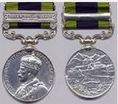
Awarded Indian General Service Medal
with clasp 'Afghanistan, N.W. Frontier 1919"
with clasp 'Afghanistan, N.W. Frontier 1919"
ROW, Ellen (Nell) Craven
Staff Nurse
AANS
Born 1884 in Clemont, Qld.
Daughter of Charles Edward ROW and Sarah Jane nee DUNLOP
Age 31 years
Enlisted 12 June 1915
Service Egypt, England and extensive service on the field in France
Promoted to Sister 21 May 1918
Returned to Australia 14 January 1919 per “City of York” On Duty
Appointment terminated 30 April 1919
Repatriation contact 03 December 1963
Did not marry
Died 1973 in Qld.
AANS
Born 1884 in Clemont, Qld.
Daughter of Charles Edward ROW and Sarah Jane nee DUNLOP
Age 31 years
Enlisted 12 June 1915
Service Egypt, England and extensive service on the field in France
Promoted to Sister 21 May 1918
Returned to Australia 14 January 1919 per “City of York” On Duty
Appointment terminated 30 April 1919
Repatriation contact 03 December 1963
Did not marry
Died 1973 in Qld.
ROWAN, Eliza
Staff Nurse
AANS
Born 1885 at Nagambie, Vic.
Daughter of Lee ROWAN and Margaret Jane nee DAVIES
Sister of Henrietta ROWAN
Read more here
AANS
Born 1885 at Nagambie, Vic.
Daughter of Lee ROWAN and Margaret Jane nee DAVIES
Sister of Henrietta ROWAN
Read more here
ROWAND, Alice Mary
|
Staff Nurse
AANS Born Oakleigh, Vic. Daughter of James William ROWAND Age 27 years Training Ovens District Hospital Enlisted 23 May 1917 in Melbourne, Vic. Embarked 12 June 1917 in Melbourne per “Mooltan” Service in Salonika Influenza March 1919 Returned to Australia 02 June 1919 per “Beltana” On Duty Appointment Terminated 27 December 1919 Died November 1946 at Private Hospital, East Melbourne, Vic. Aged 56 years Read more here |
Gaol Sub-matron's Death After Fall
Miss Alice Rowand, 56, who was sub-matron and nurse at Pentridge Gaol, died yesterday in a private hospital in East Melbourne as the result of a fall on a stairway at Pentridge on November 24 last. During the 1914-1918 she served abroad for three years as an Army sister with the AIF.
The Argus Monday 14 January 1946 page 5
Miss Alice Rowand, 56, who was sub-matron and nurse at Pentridge Gaol, died yesterday in a private hospital in East Melbourne as the result of a fall on a stairway at Pentridge on November 24 last. During the 1914-1918 she served abroad for three years as an Army sister with the AIF.
The Argus Monday 14 January 1946 page 5
ROWE, Alice Margaret
Staff Nurse
AANS
Born 1875 in St. Arnaud, Vic.
Daughter of James ROWE and Ellen Elizabeth nee HENDEN
Sister of Mr. W J ROWE
Age 41 years
Training Alfred Hospital
Enlisted 02 April 1917 in Melbourne, Vic
Embarked 21 April 1917 in Melbourne per “Karoola”
Service in France and on the field
Promoted to Sister 01 June 1919
Influenza in January 1919
Returned to Australia 08 October 1919 per “Benalla” On Duty
Appointment Terminated 24 January 1920
Did not marry
Died 23 September 1943 in Kew, Vic.
Late of Kew Vic.
Buried 24 September 1943 in Box HIll Cemetery CE 214-0005
AANS
Born 1875 in St. Arnaud, Vic.
Daughter of James ROWE and Ellen Elizabeth nee HENDEN
Sister of Mr. W J ROWE
Age 41 years
Training Alfred Hospital
Enlisted 02 April 1917 in Melbourne, Vic
Embarked 21 April 1917 in Melbourne per “Karoola”
Service in France and on the field
Promoted to Sister 01 June 1919
Influenza in January 1919
Returned to Australia 08 October 1919 per “Benalla” On Duty
Appointment Terminated 24 January 1920
Did not marry
Died 23 September 1943 in Kew, Vic.
Late of Kew Vic.
Buried 24 September 1943 in Box HIll Cemetery CE 214-0005
ROWE, Bessie Frazer
|
Staff Nurse
AANS Born 26 June 1889 in Wilcannia, NSW Daughter of James ROWE and Madeline Lillian nee GRANT NOK Broken Hill, NSW Training at Broken Hill Hospital Date of Appointment 08 November 1918 Duty at 15th and 7th AGH Rejected AIF due to dental problems Demobilized 13 August 1919 Married Frank JARRET in 1929 in New Lambton, NSW Died January 1958 in Sydney, NSW Aged 68 years Courtesy of Graham Medlin |
ROWE, Dora Irene
|
Staff Nurse
AANS Born 23 April 1889 at Exter, SA Daughter of Rev. George Edward ROWE and Marian Perkins nee PAUL Age 28 years Enlisted 01 September 1917 in Brisbane, Qld. Embarked 15 September 1917 per “Ayreshire” Service in Egypt Returned to Australia 22 December 1918 per “Leicestershire” On Duty Appointment terminated 30 April 1919 Married Dr. Andrew Buchanan STEELE in 1919 Died 15 January 1972 in Qld. Aged 83 years Buried Mt. Thompson Memorial Gardens Columbarium 10 Section 22 Photograph Courtesy of Faye Threlfall WW1 Australian and New Zealand Nurses |
ROWE, Valerie
|
Sister
AANS Born 18 September 1889 at Jamestown, SA Daughter of Richard ROWE and Mary Ellis nee MATHEWS Age 26 years Training Adelaide Hospital Enlisted 21 September 1915 Nursing duties with No6 Infectious Hospital till embarkation Embarked 24 August 1916 in Adelaide per “Mooltan” Service in India, Salonika and England Promoted to Sister 18 November 1918 Applied to join Queen Alexandra’s Military Nursing Service for India in July 1919 Resigned with AIF in England 06 October 1919 upon acceptance with QAMNS Returned to India and was expecting to nurse there for the foreseeable future Sister’s address in 1921 was at Military Station Hospital Rawalpindi, Punjab, India Trained as a dispenser in England before returning to Australia. A family notice for the death of her father Richard in 1928 shows her living in Maymyo, India. The death of her mother in 1939 shows her still living in India. She did not marry Died in Adelaide 4 September 1974. Cremated 6 September 1974 at Centennial Park. Location RSL, Wall 107, Niche B014 |
